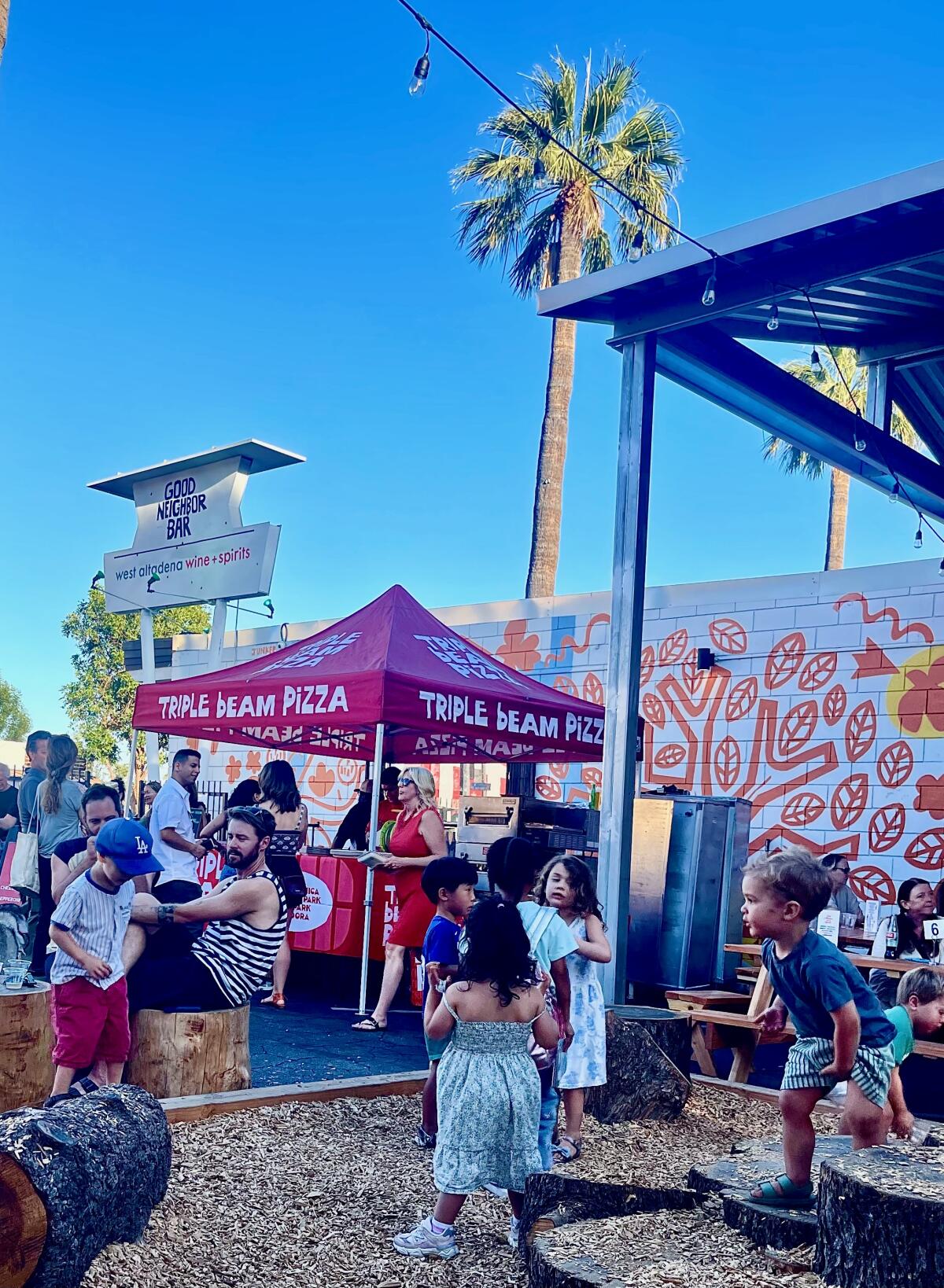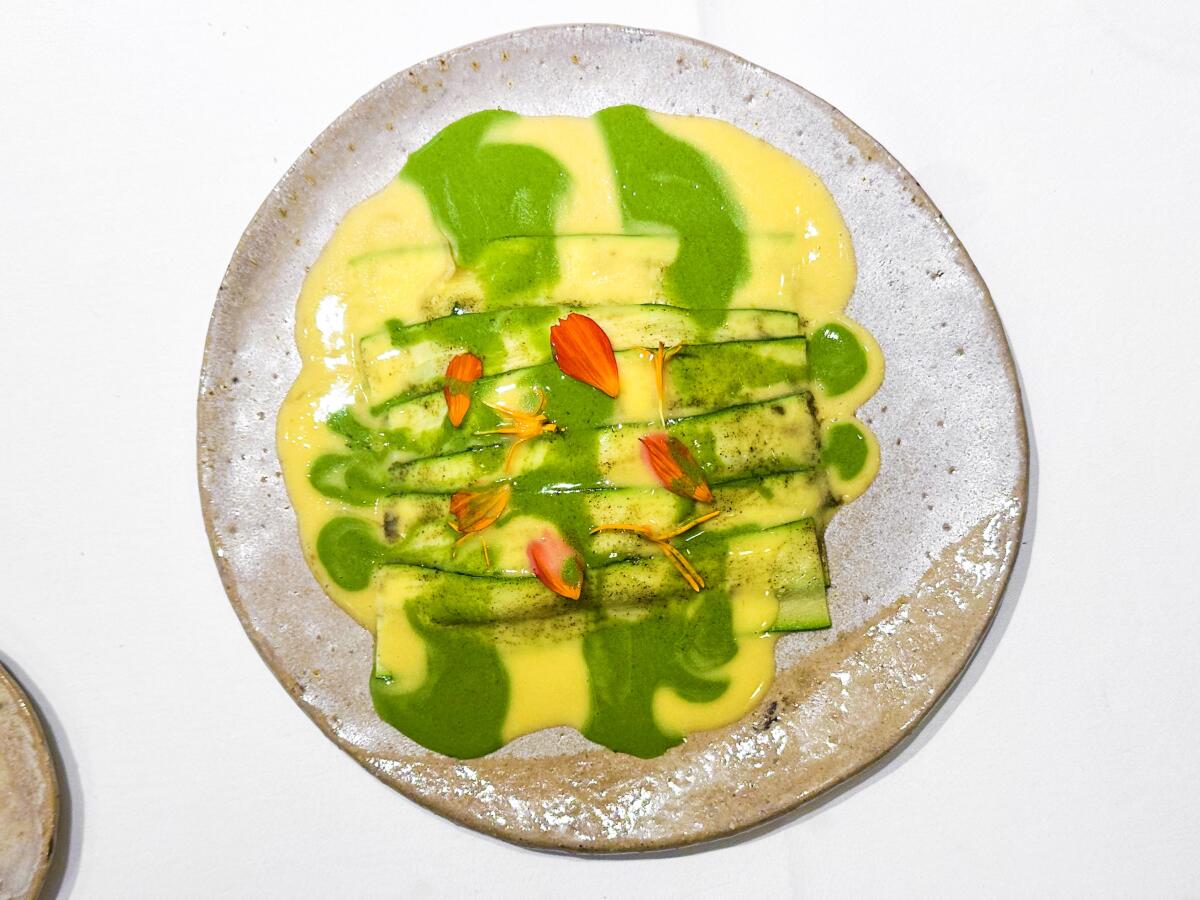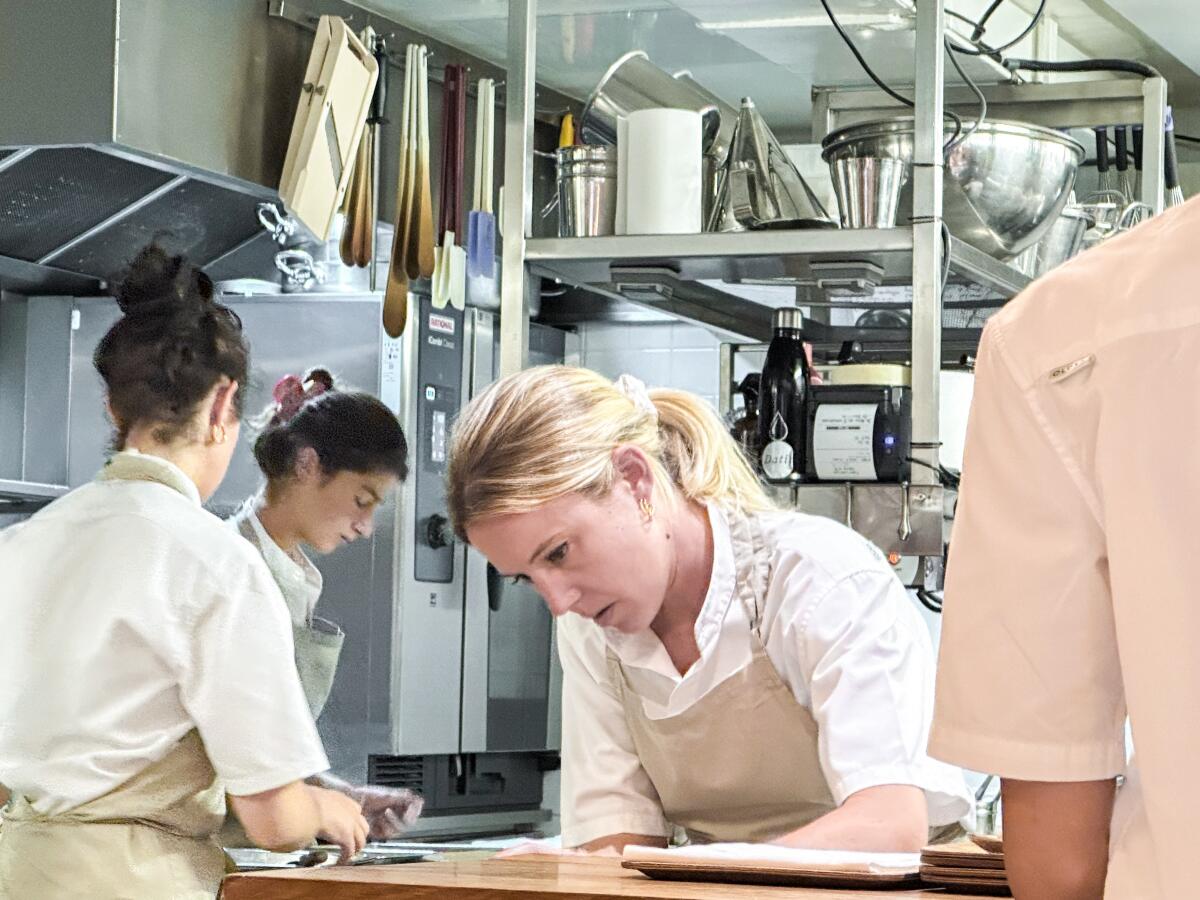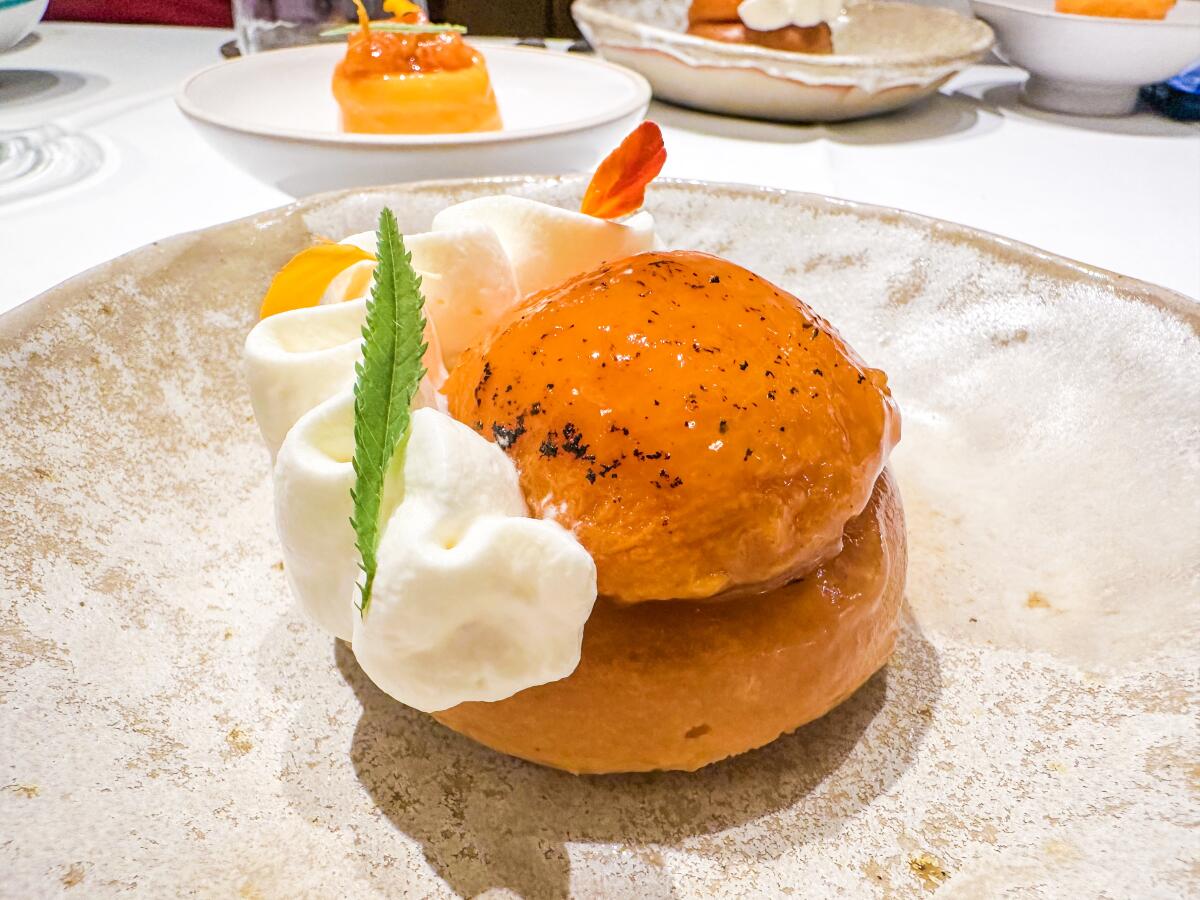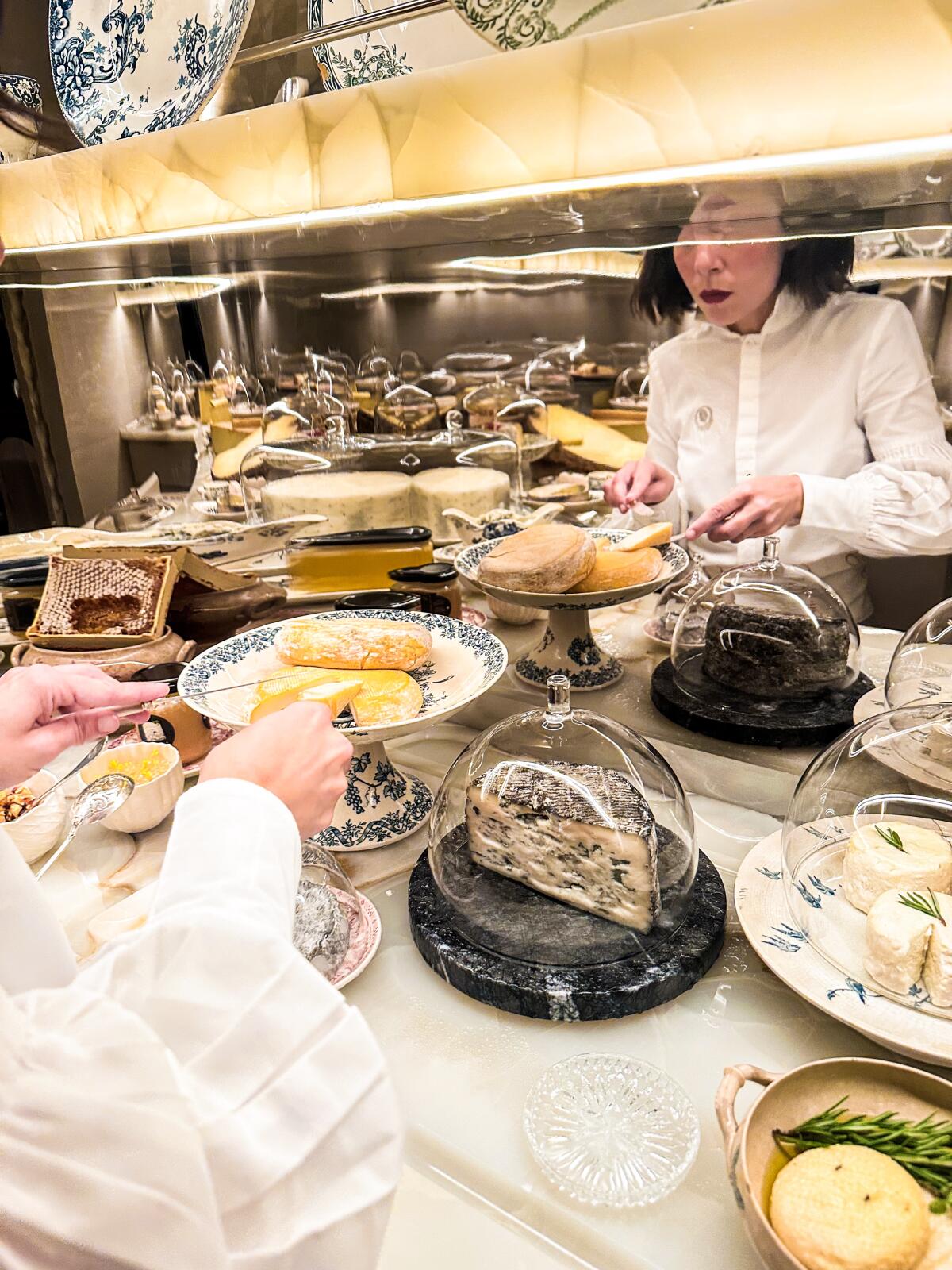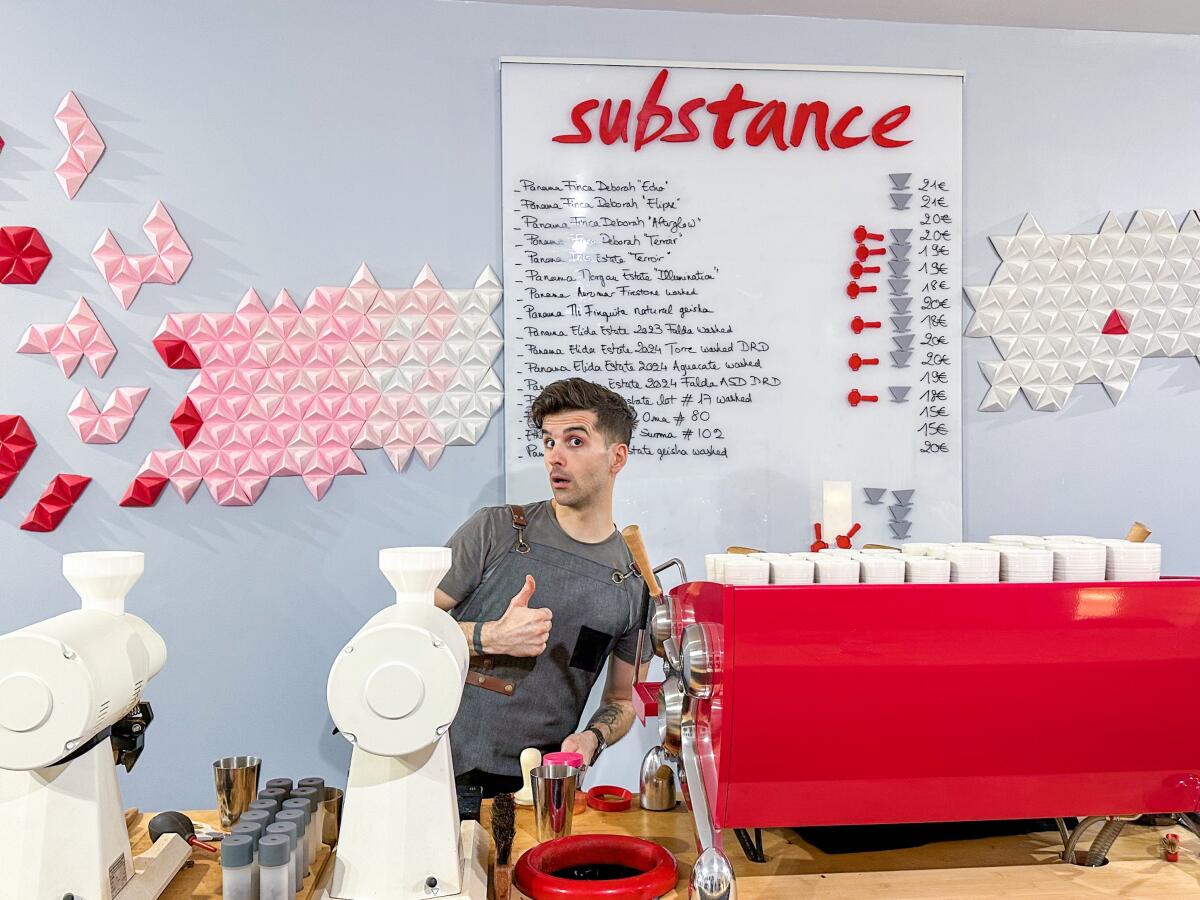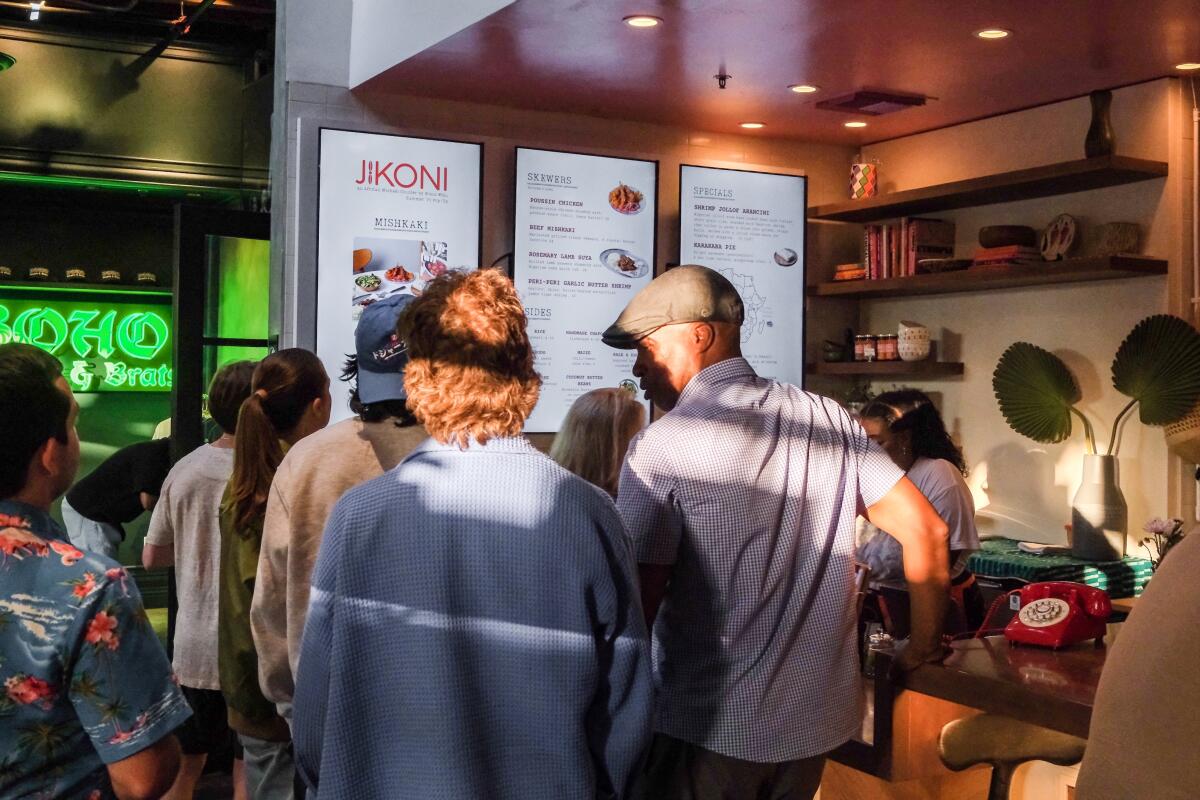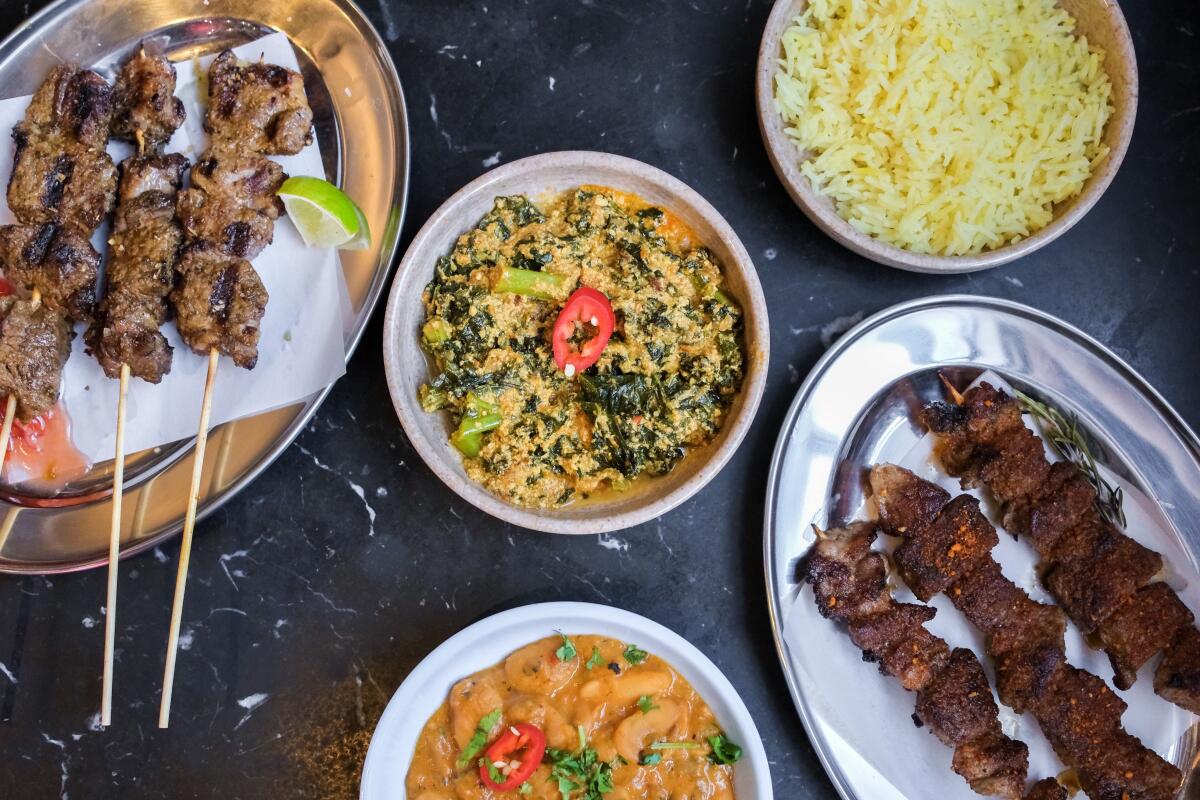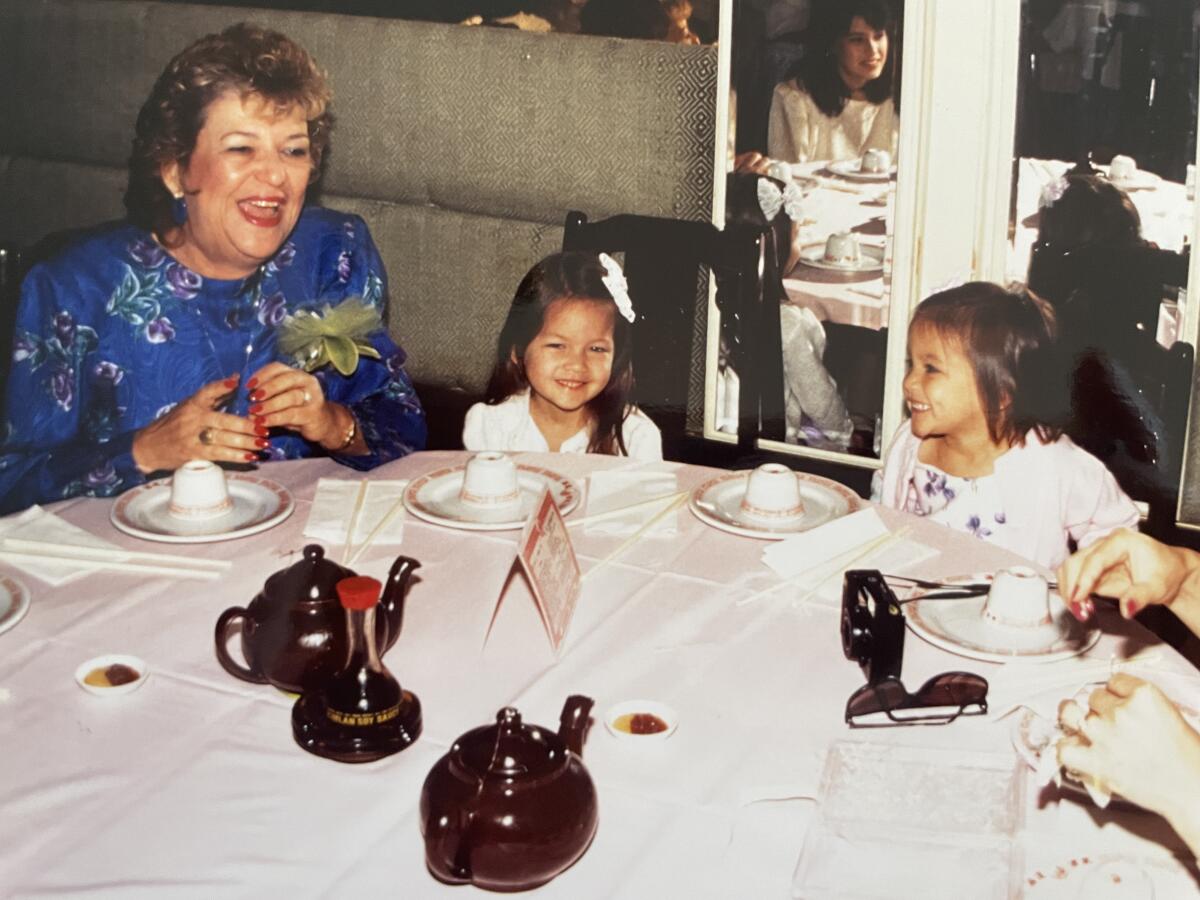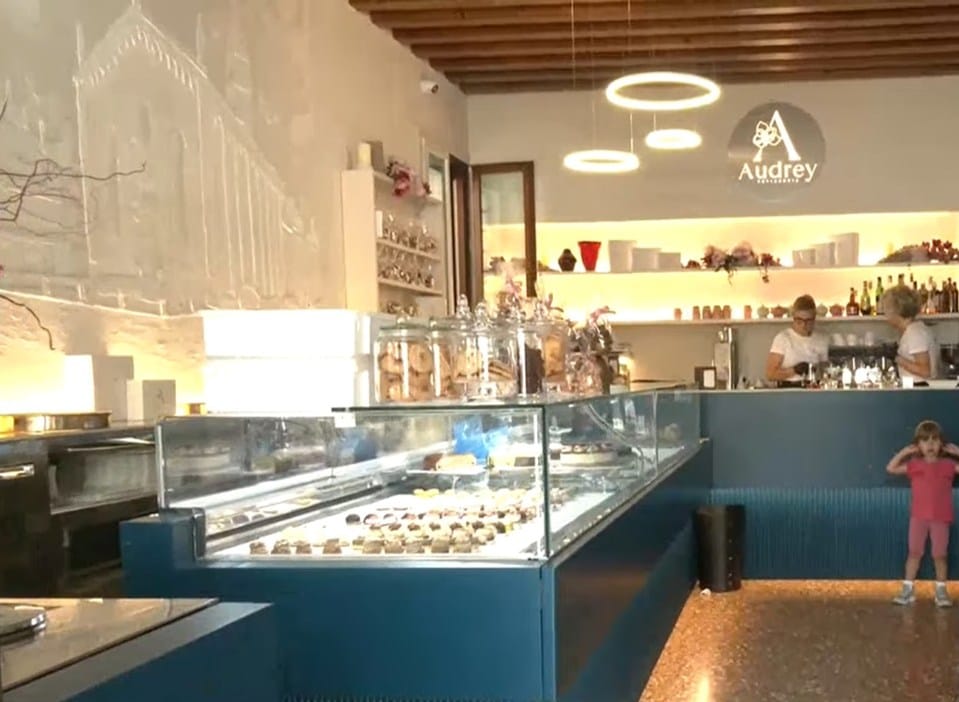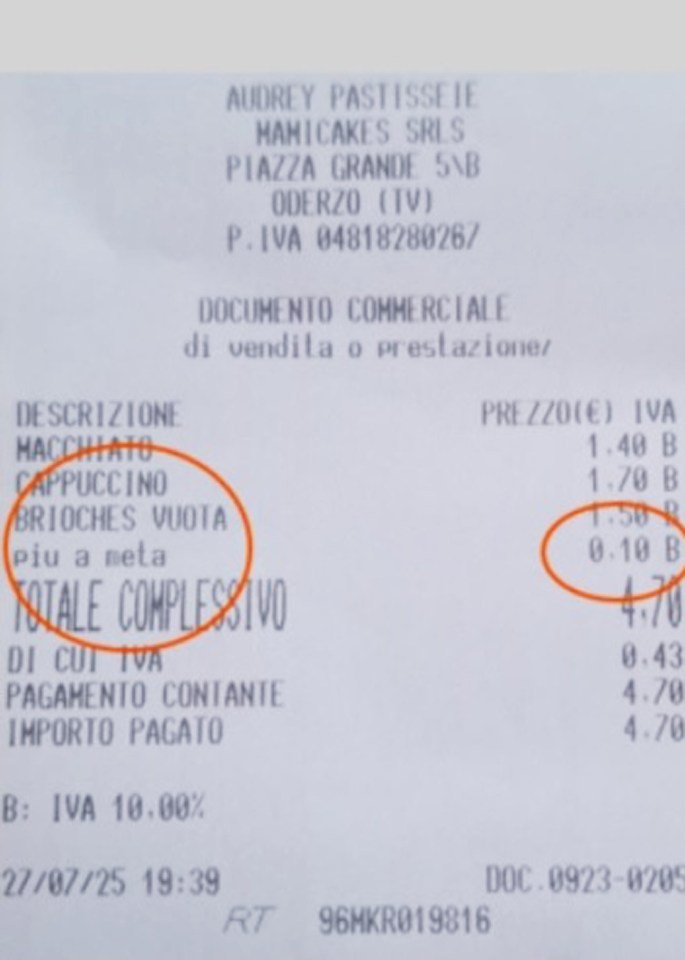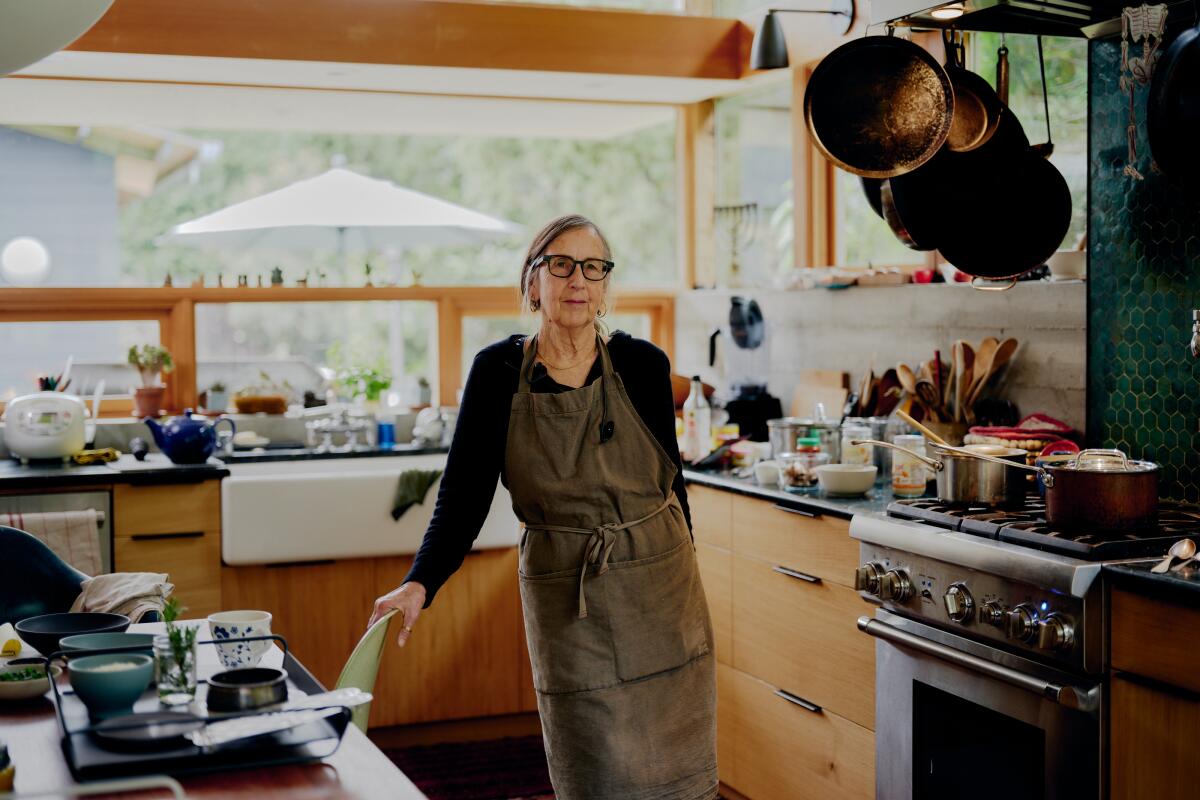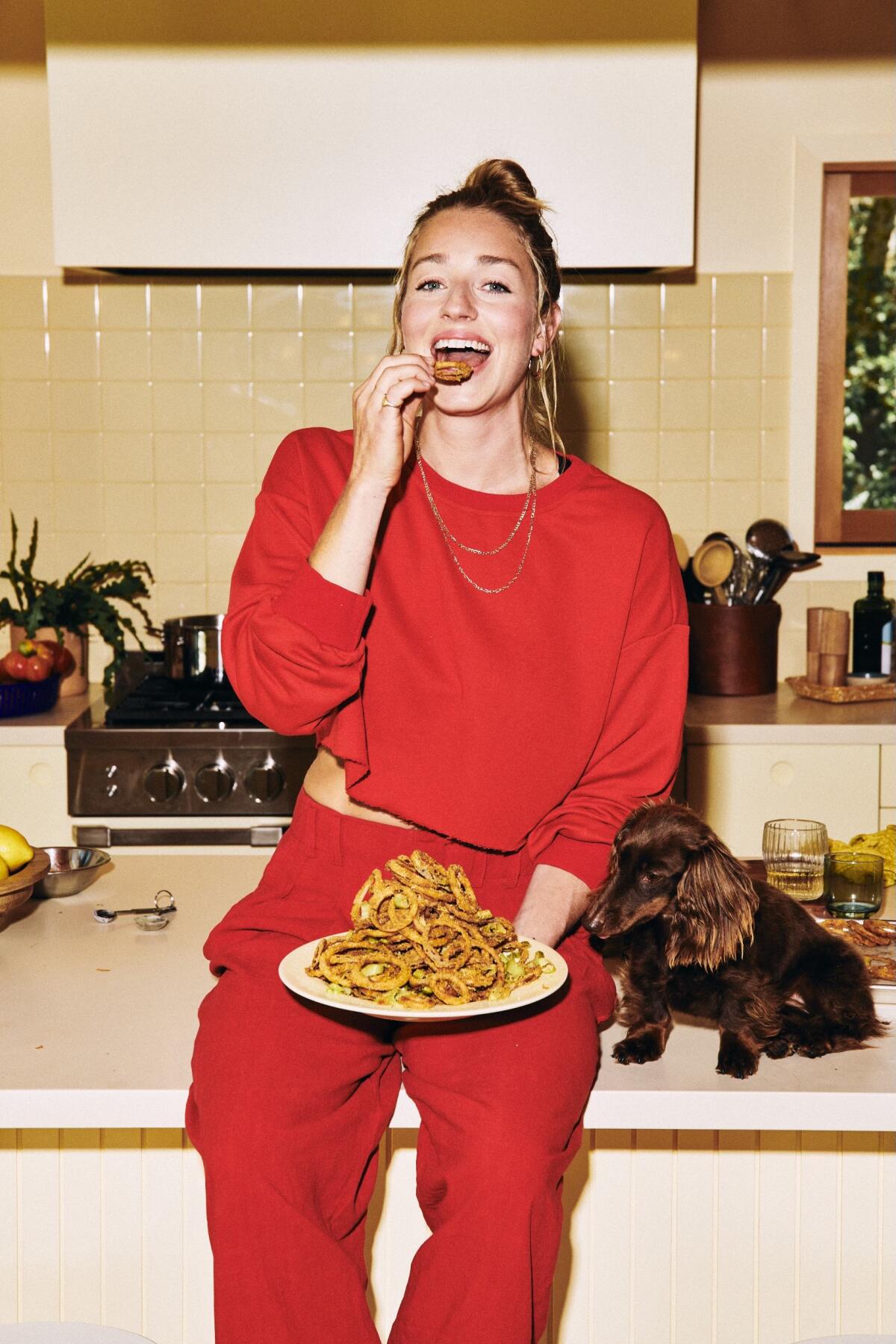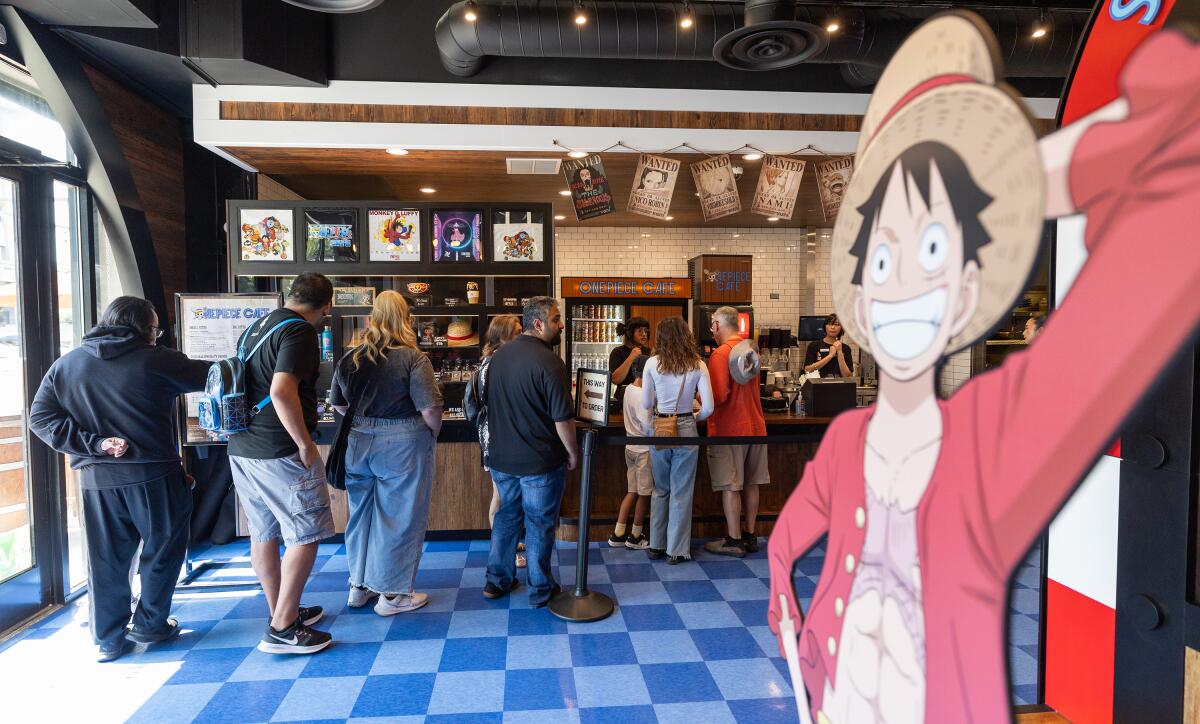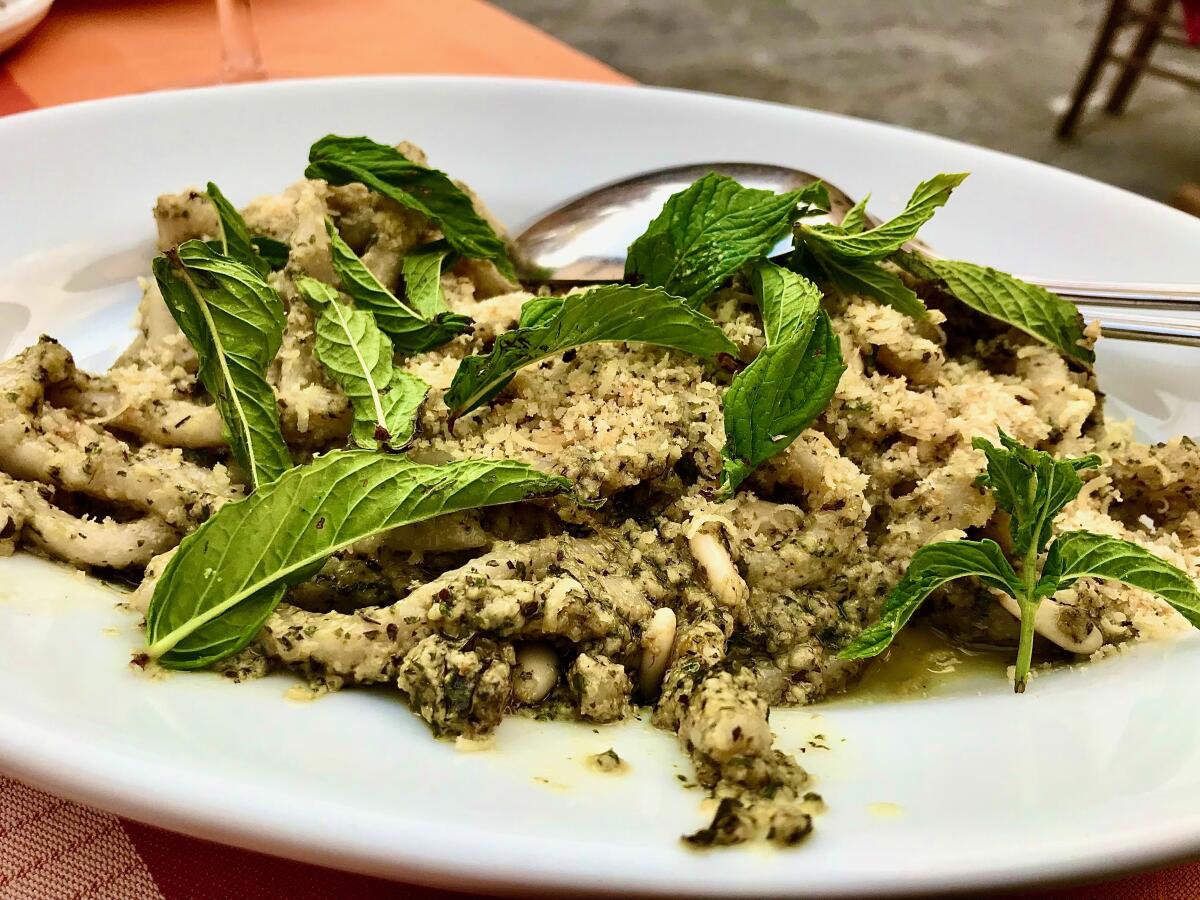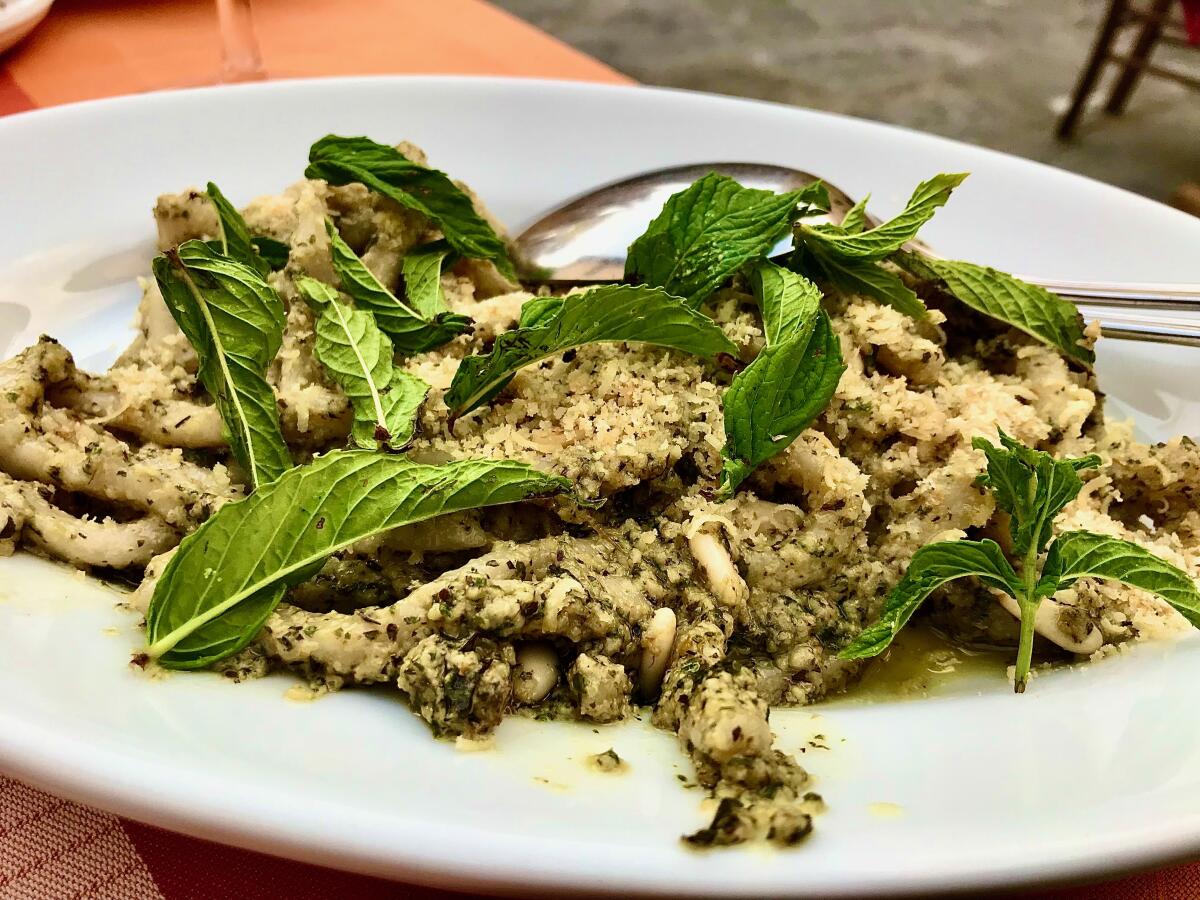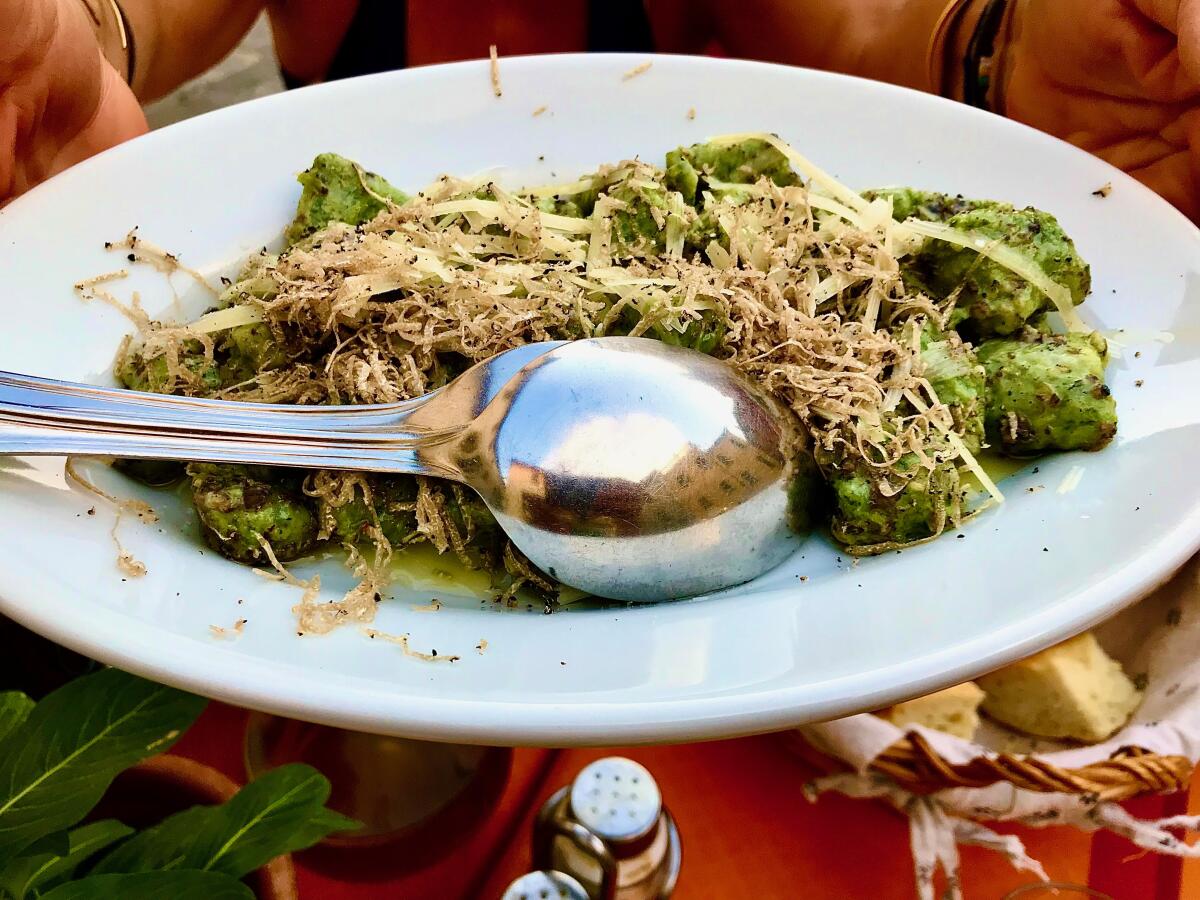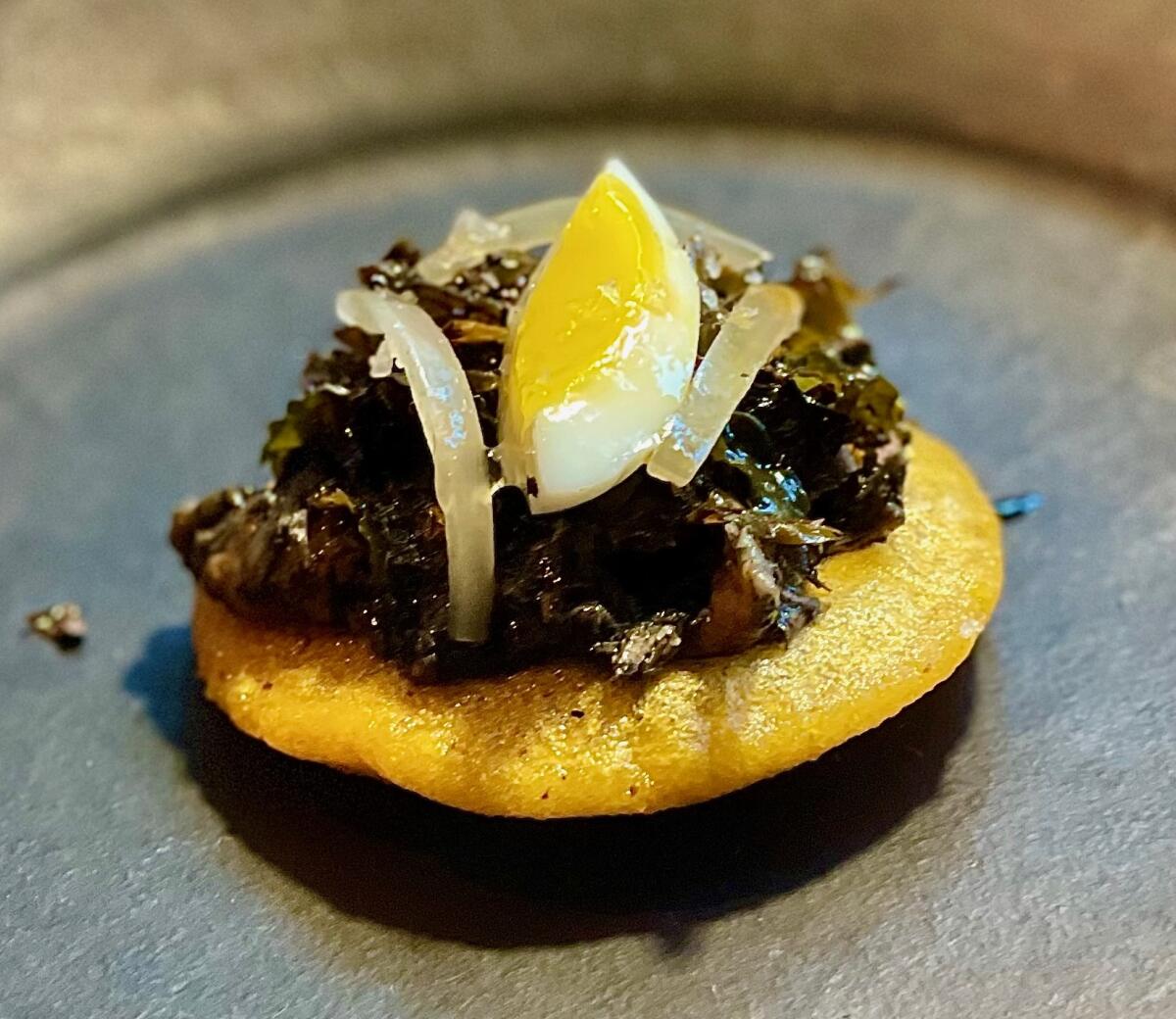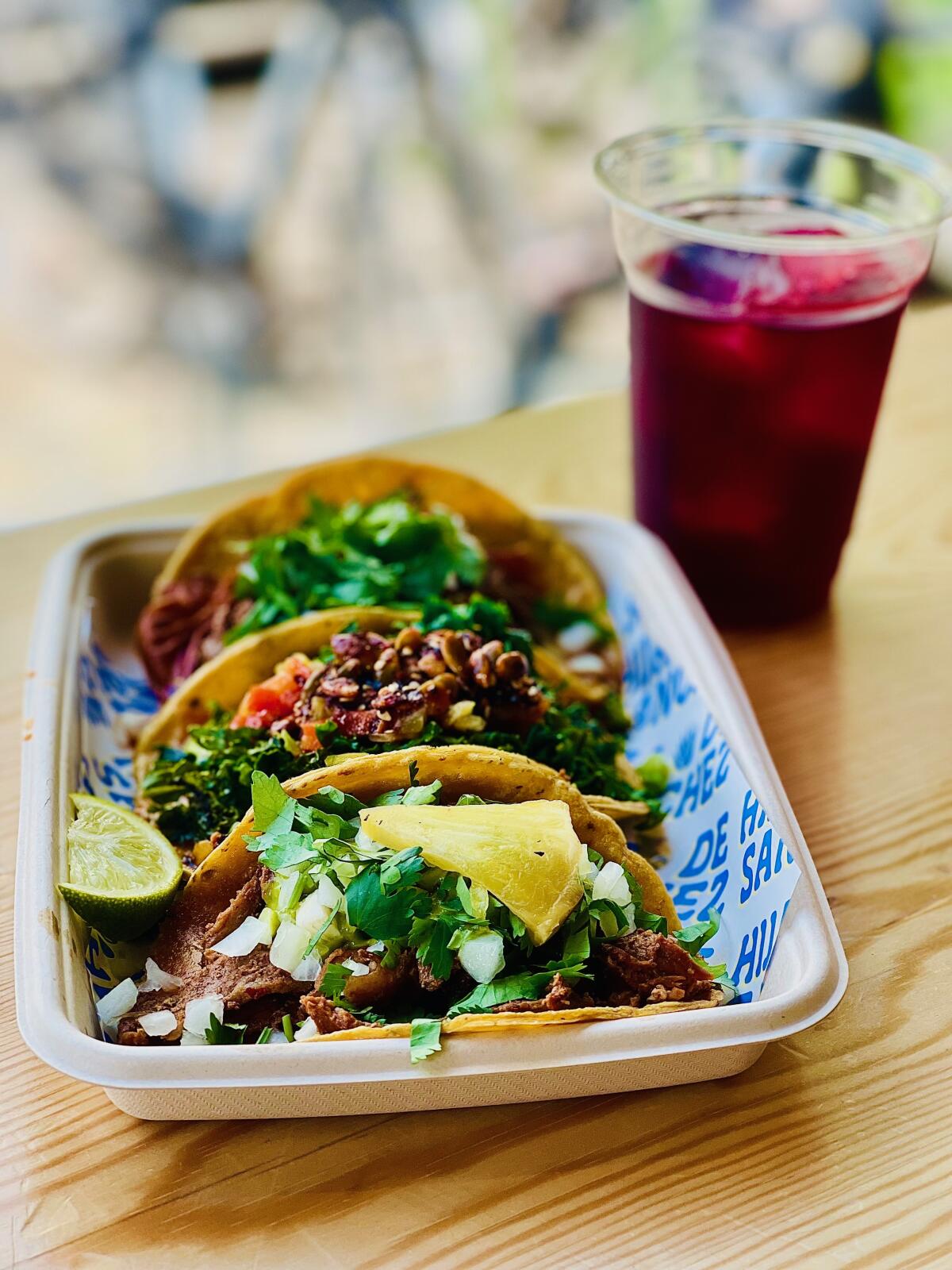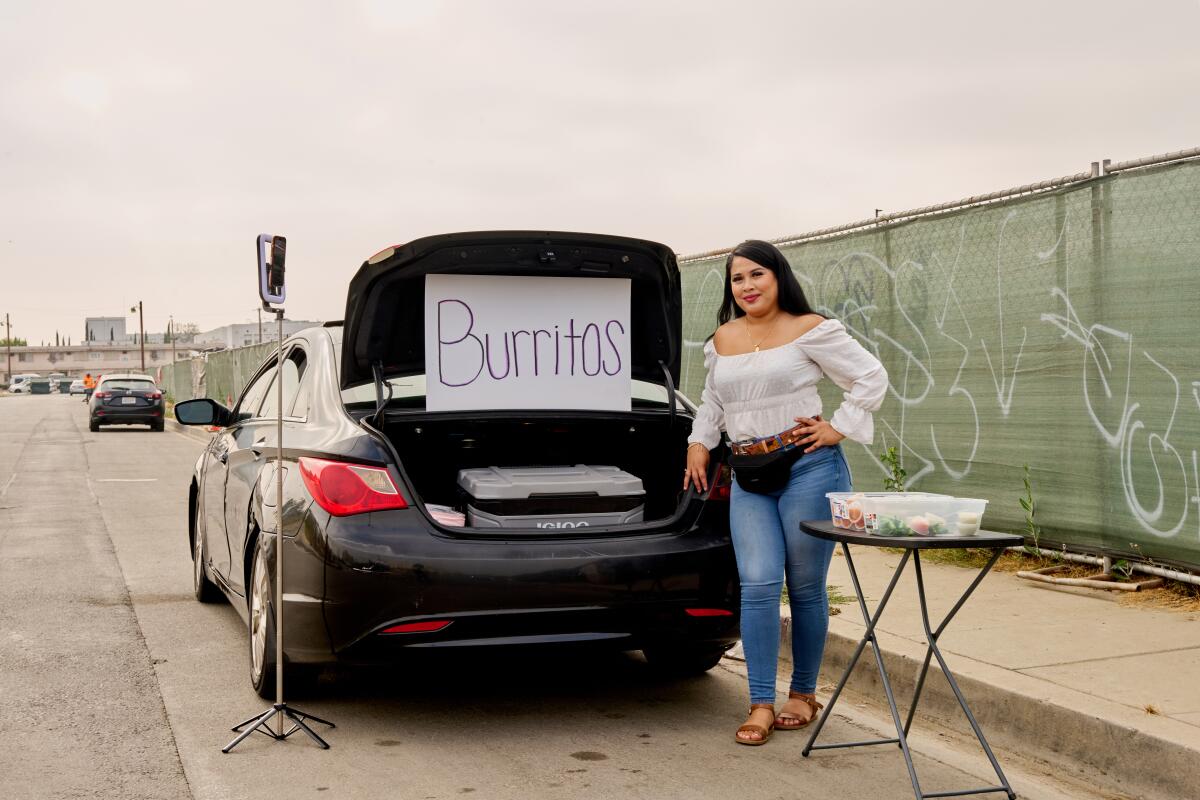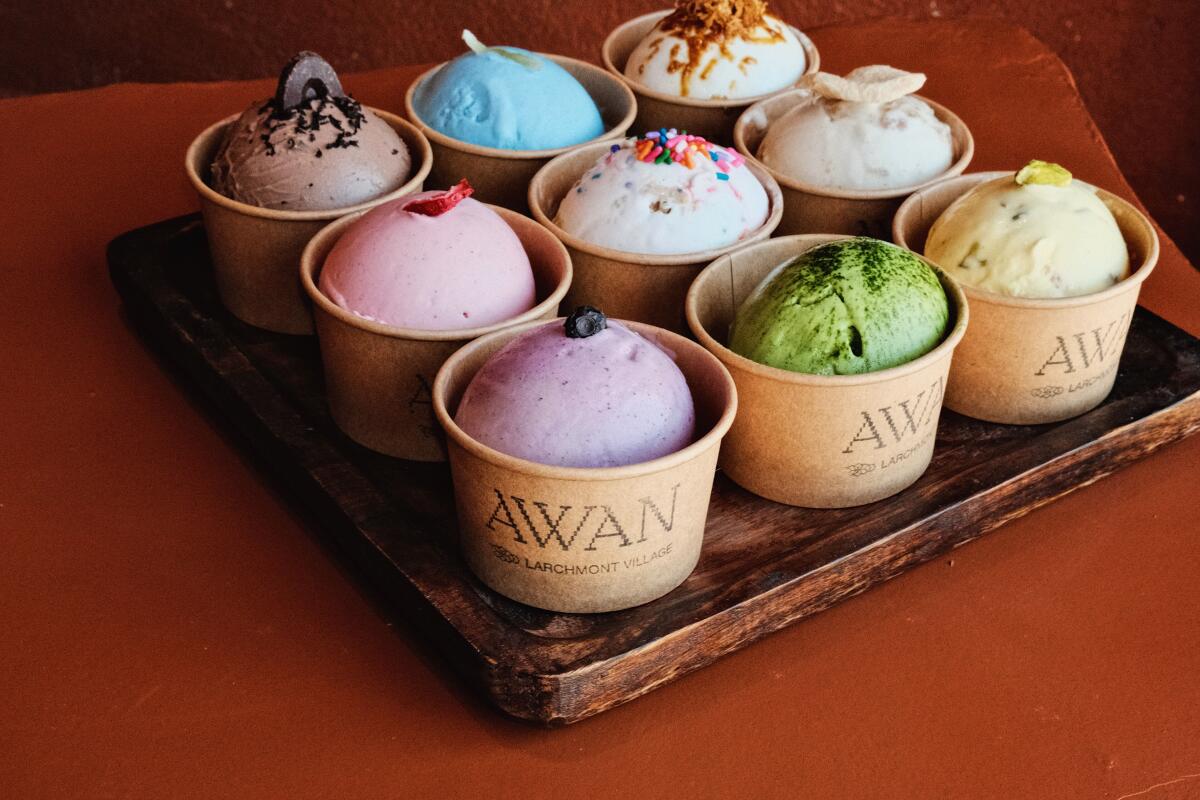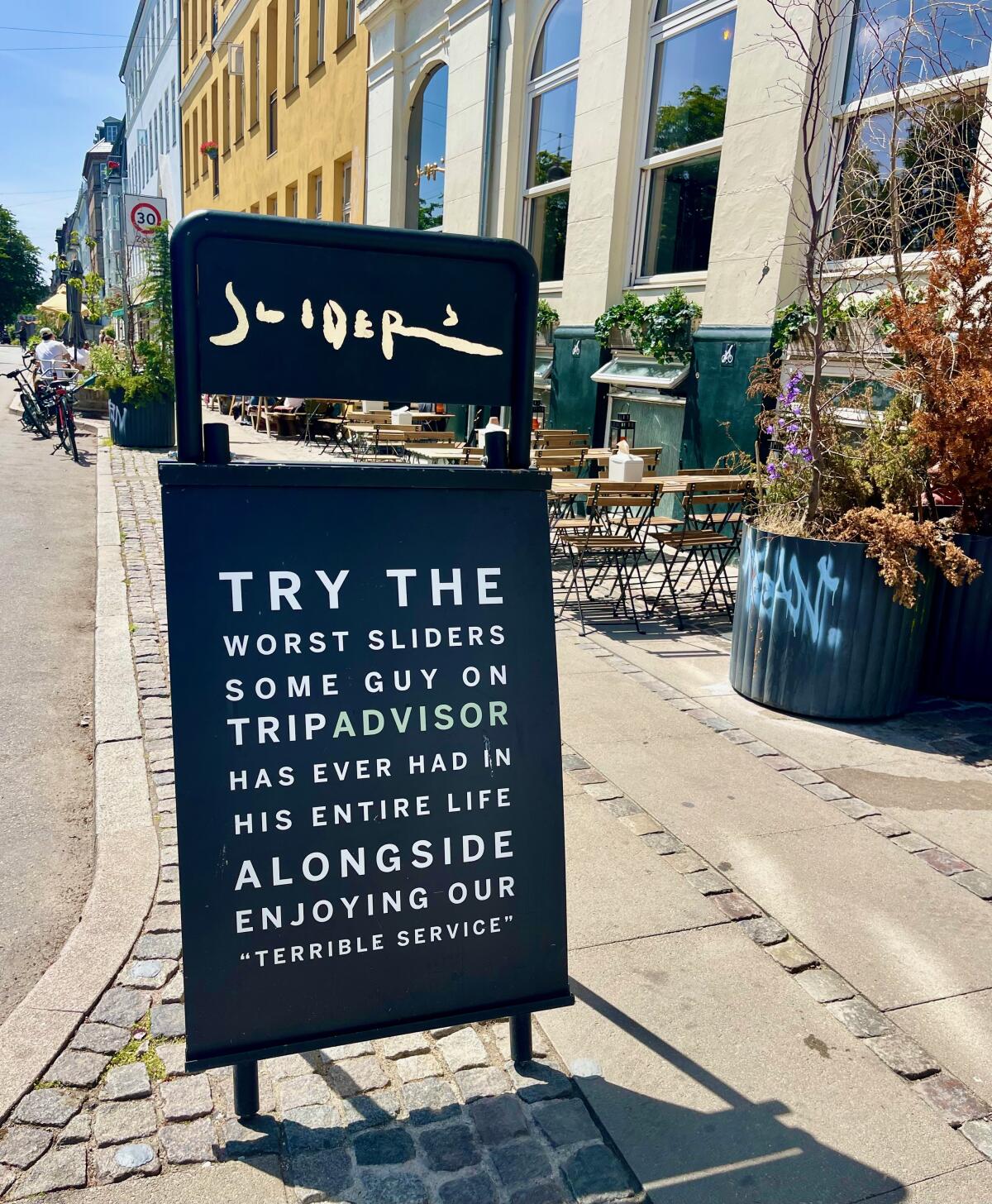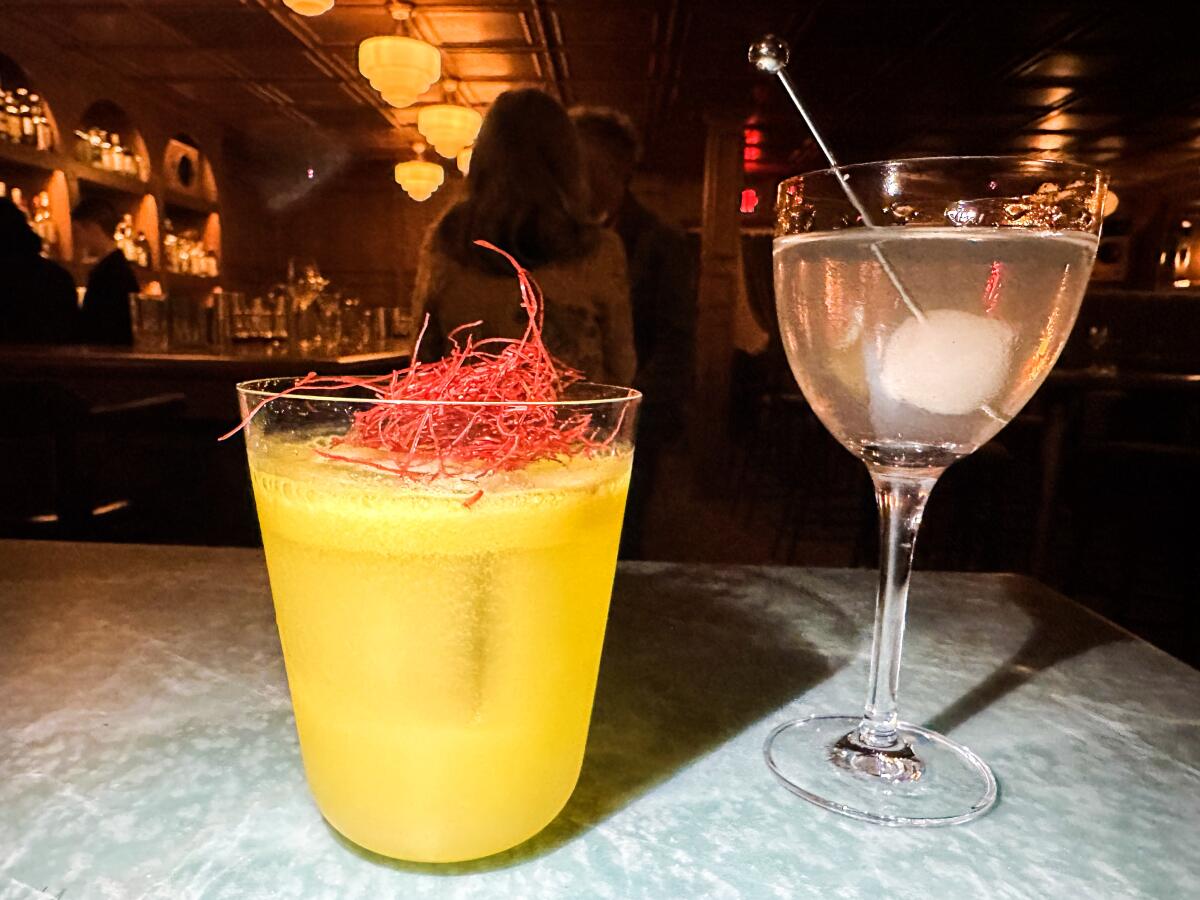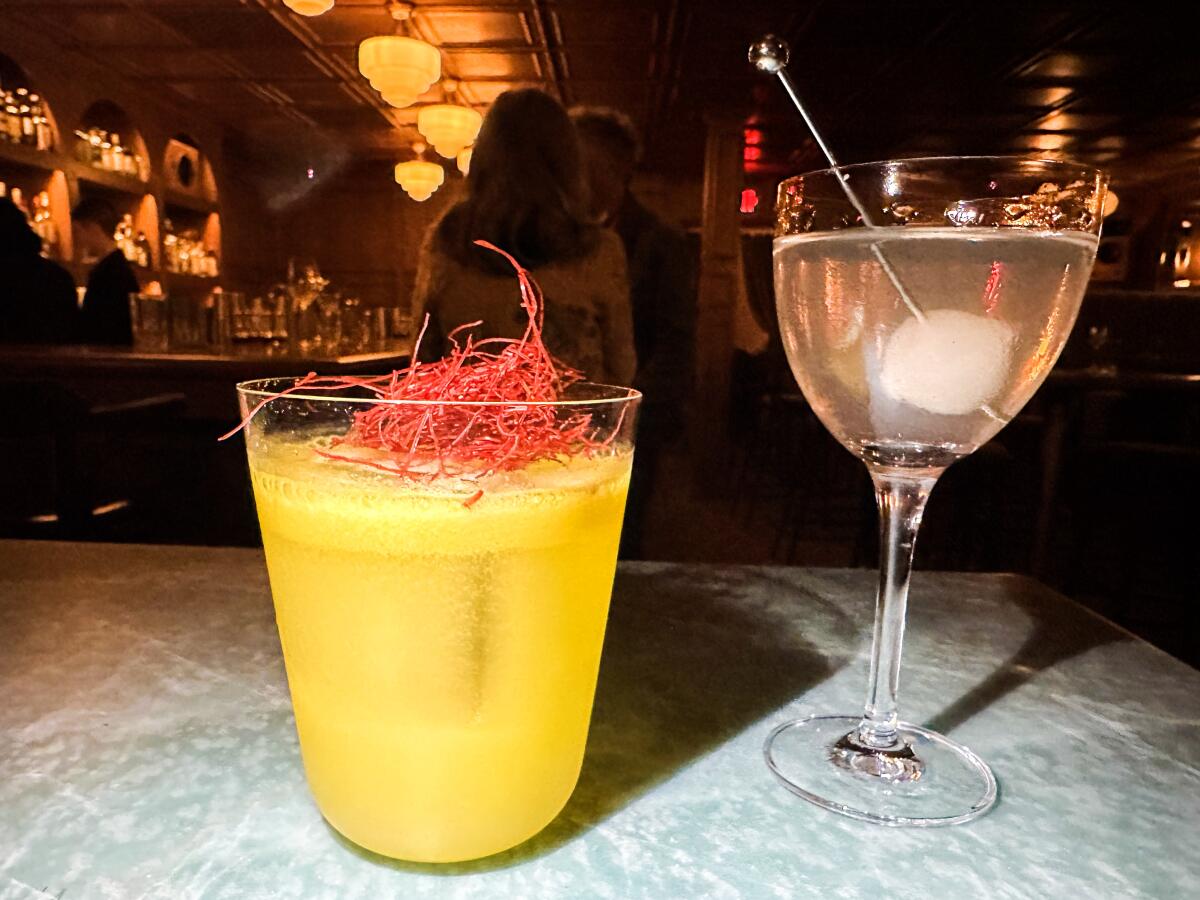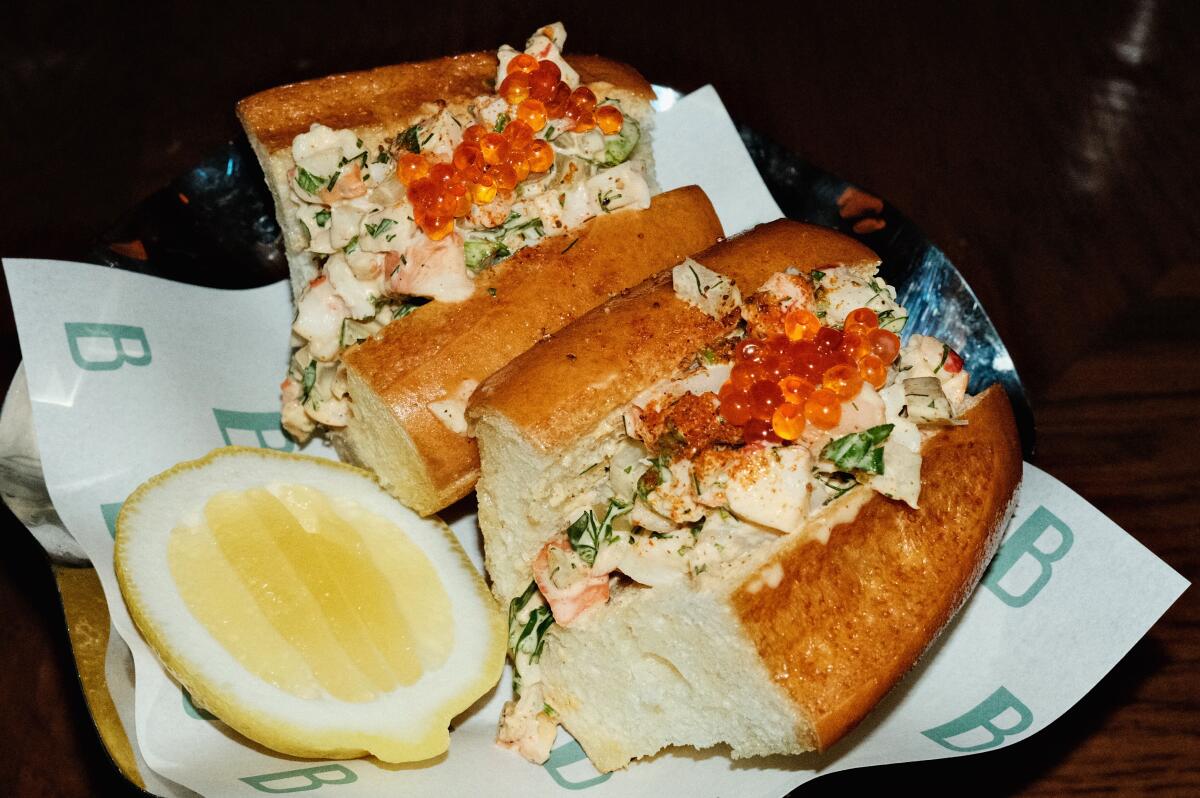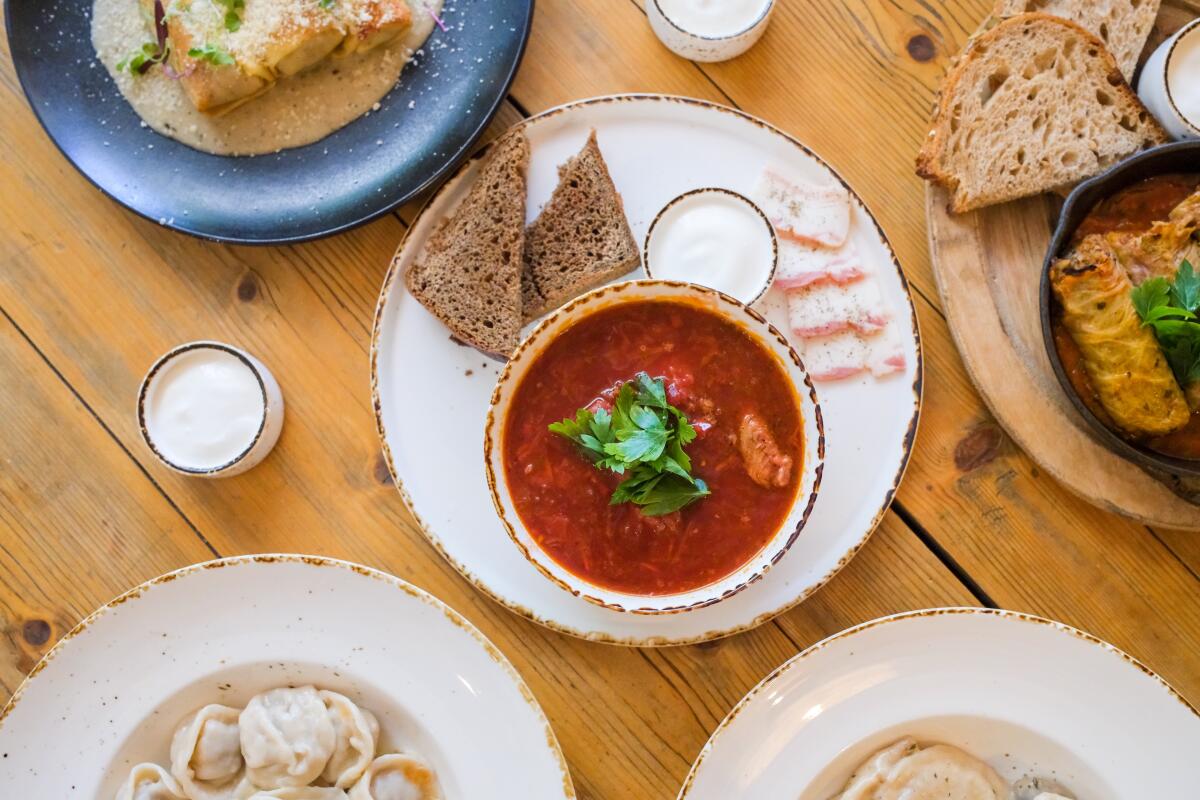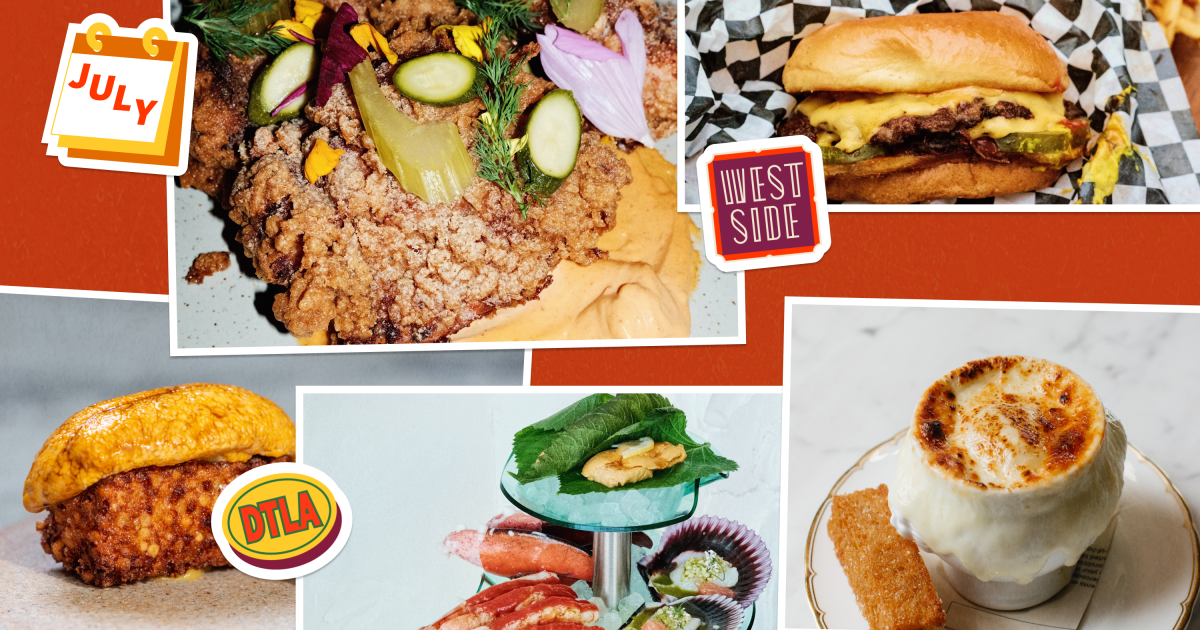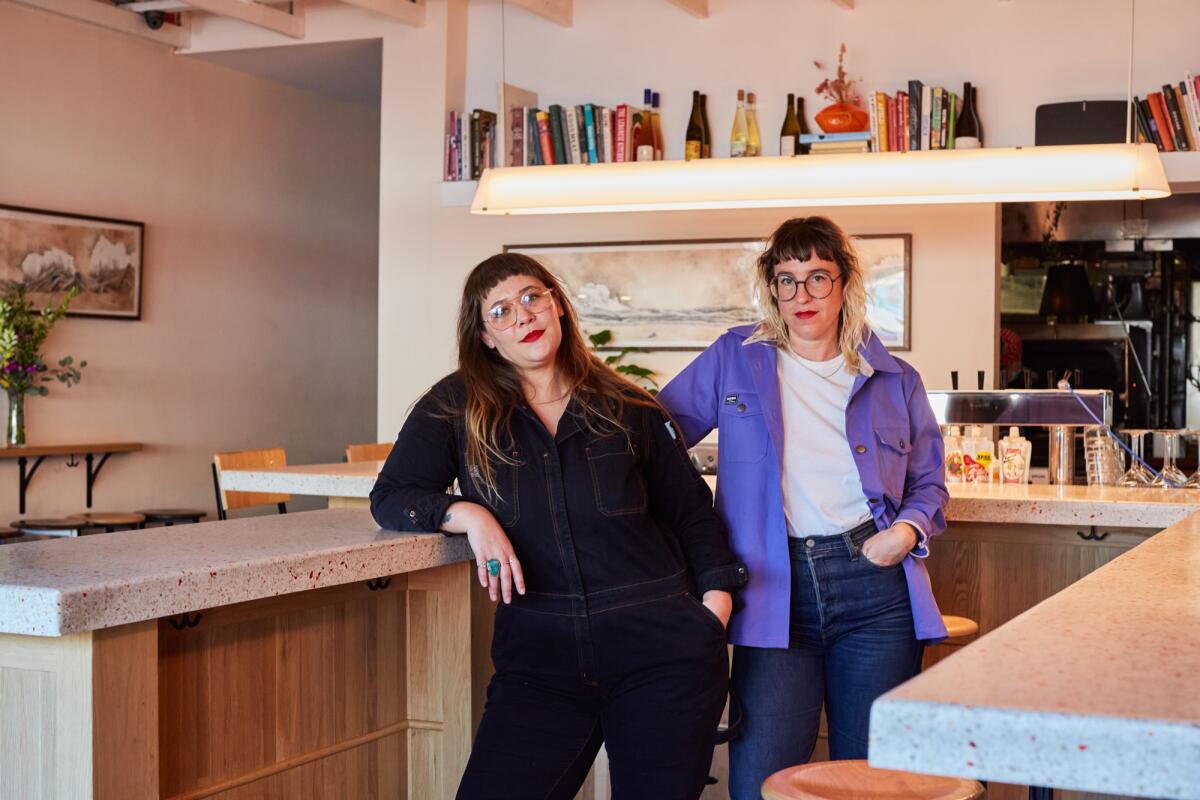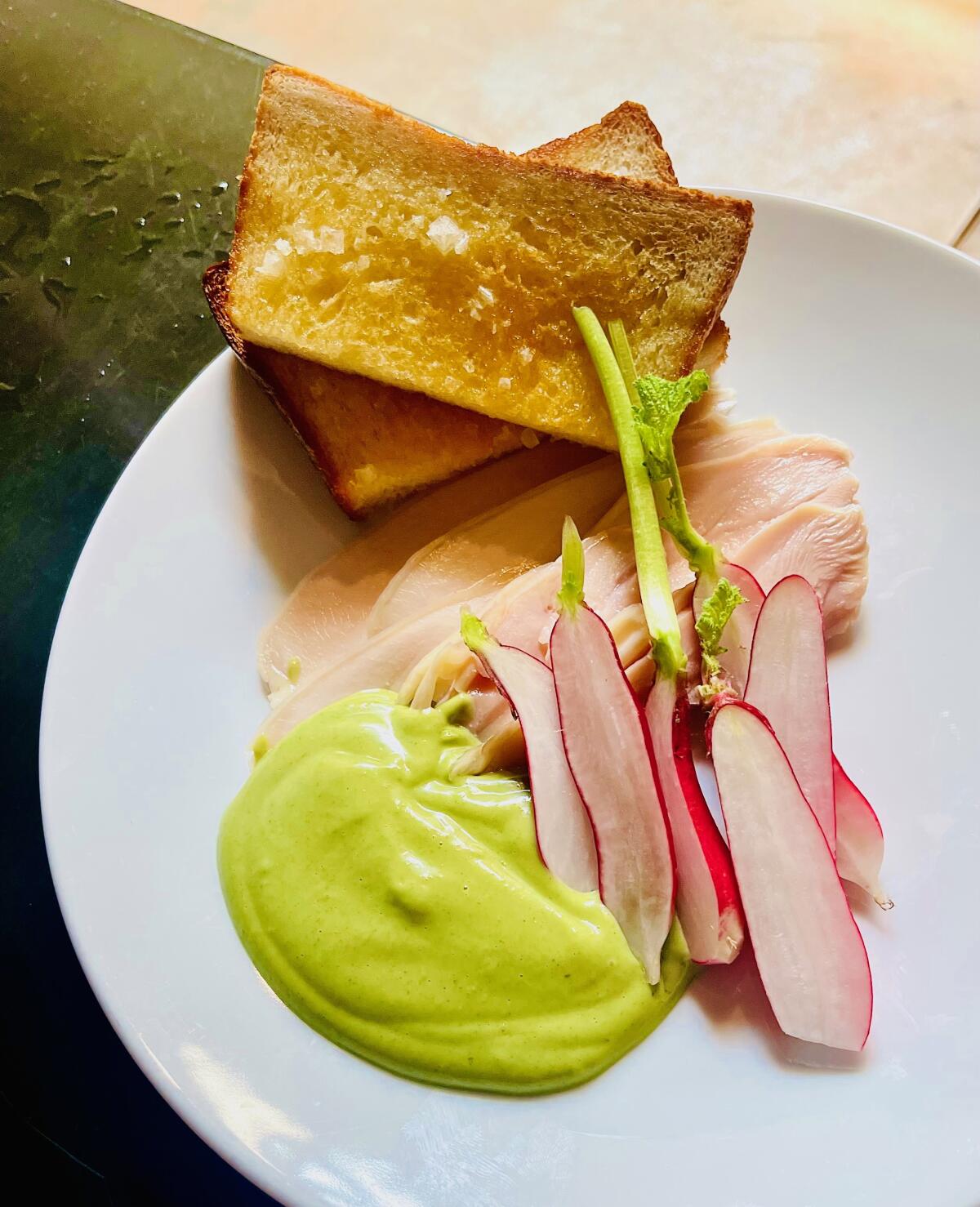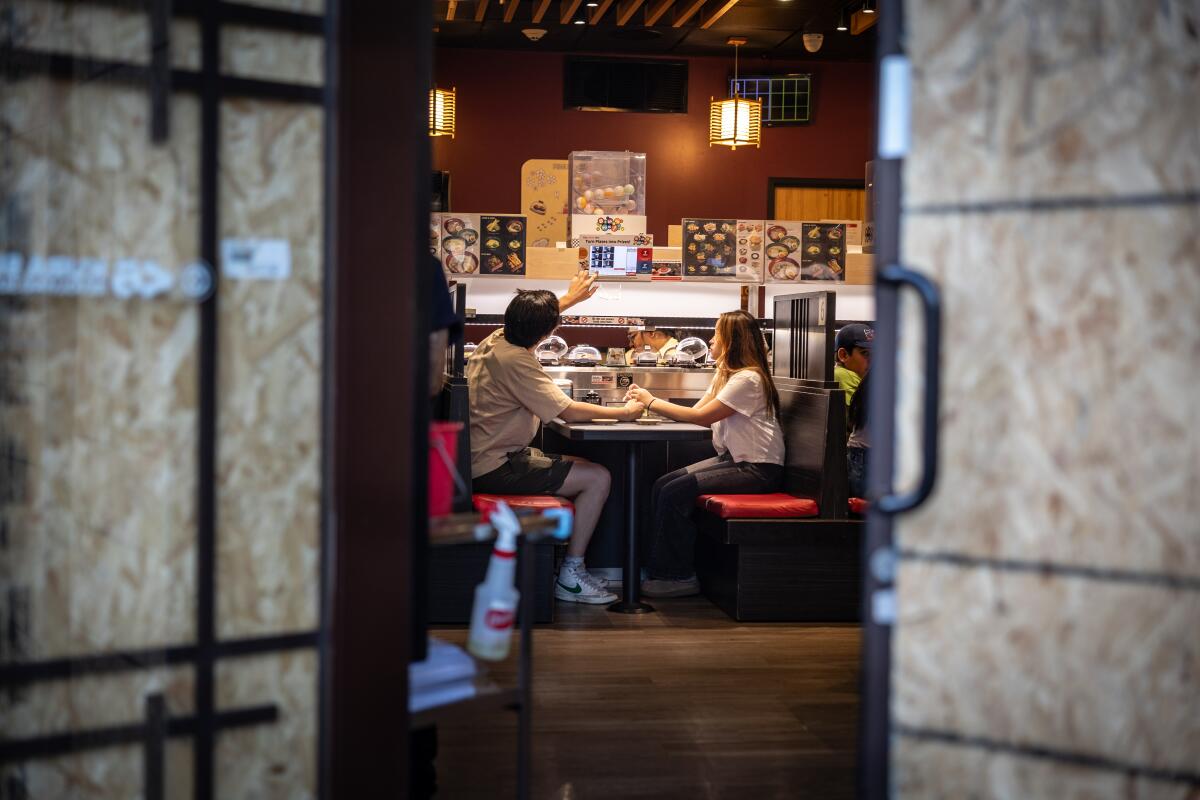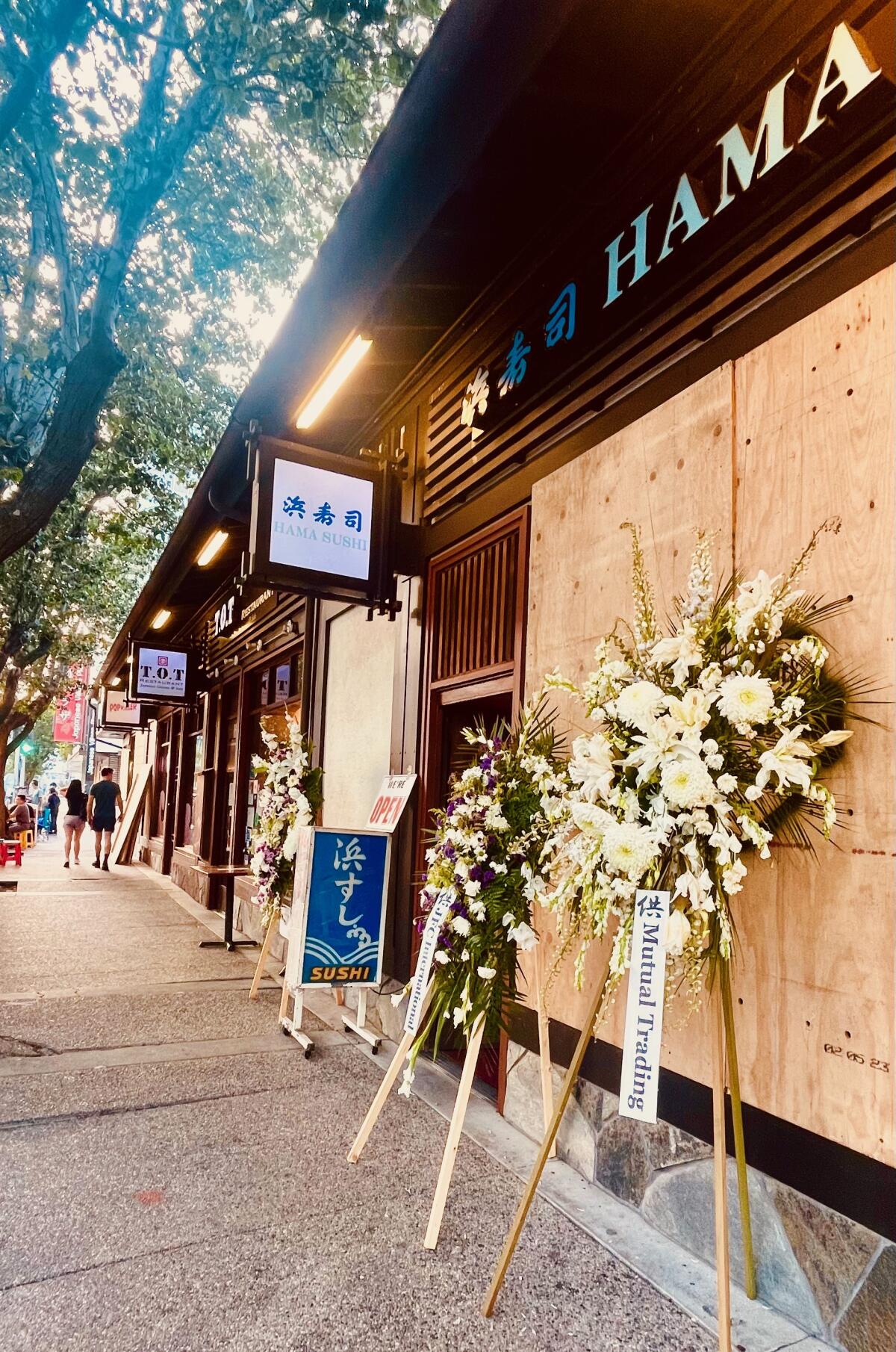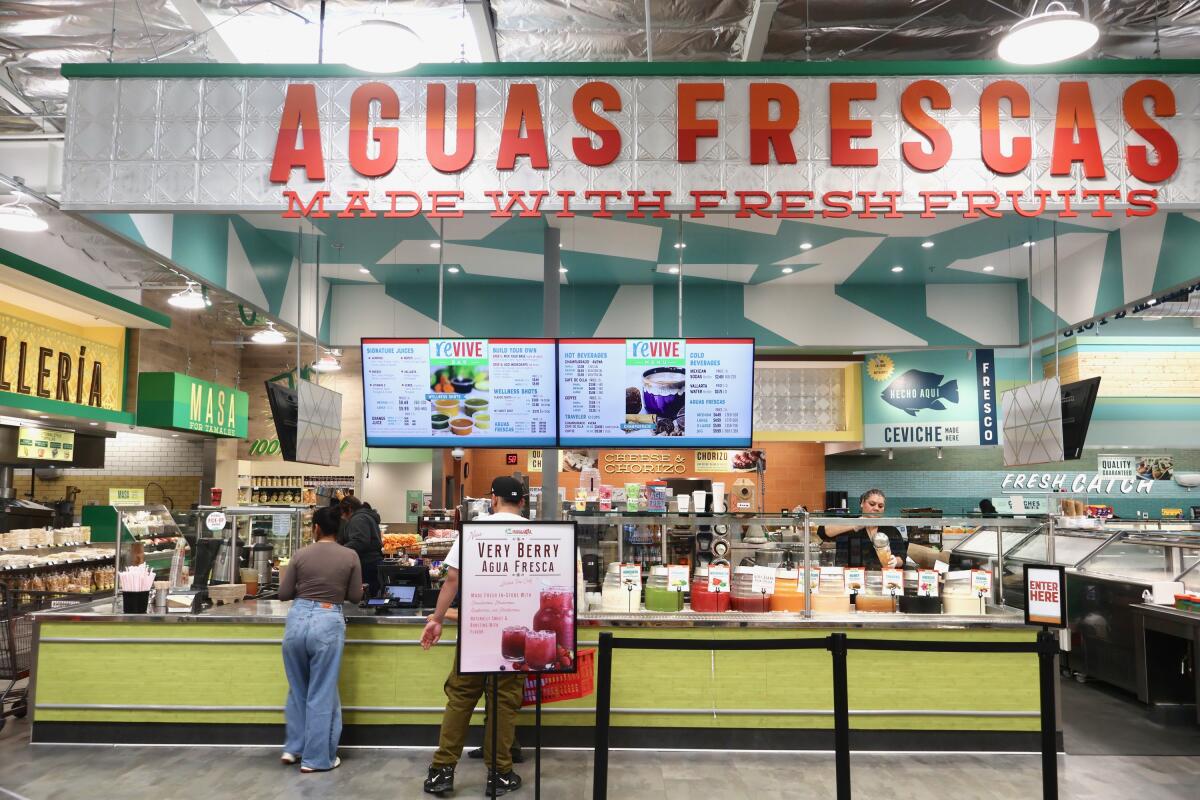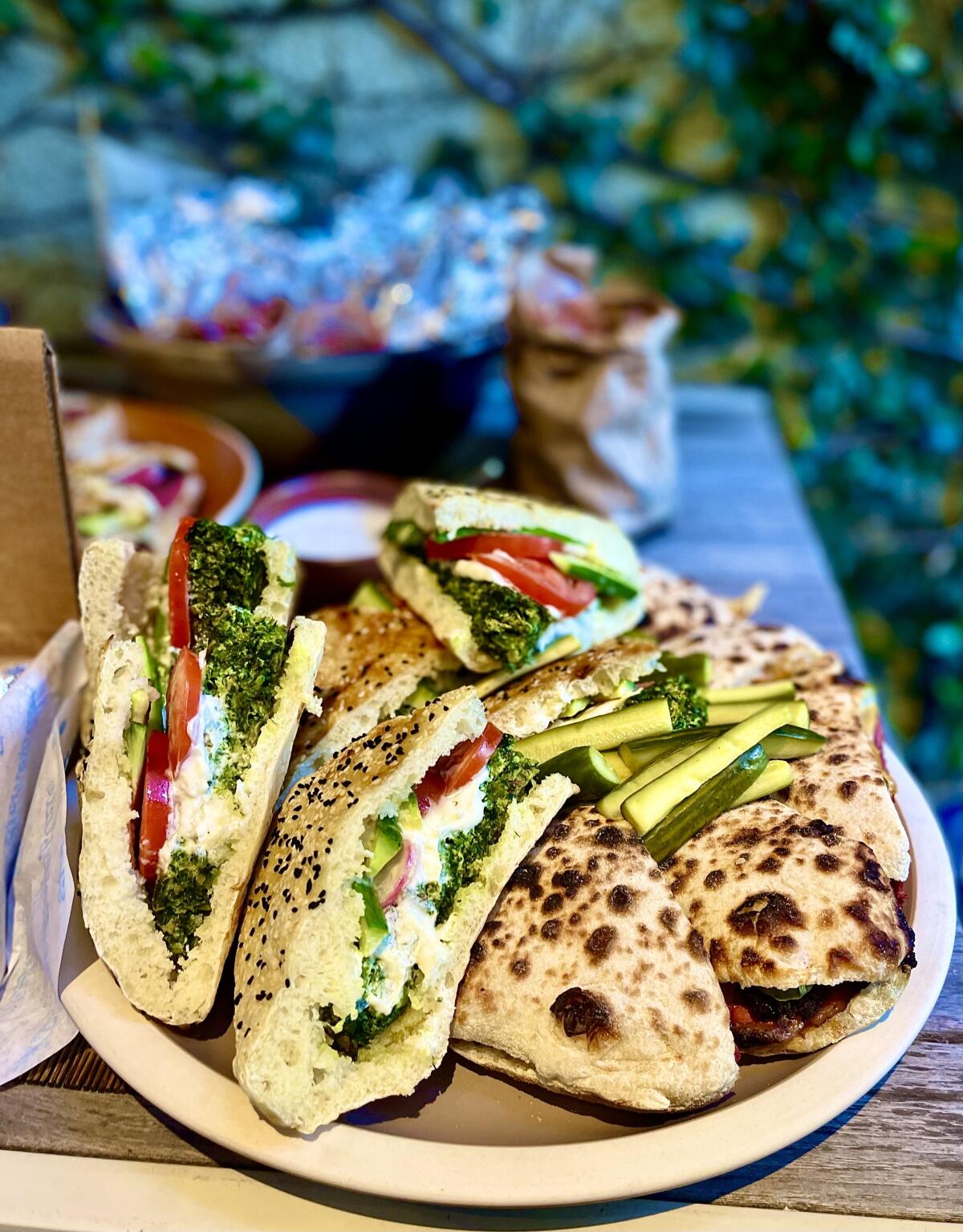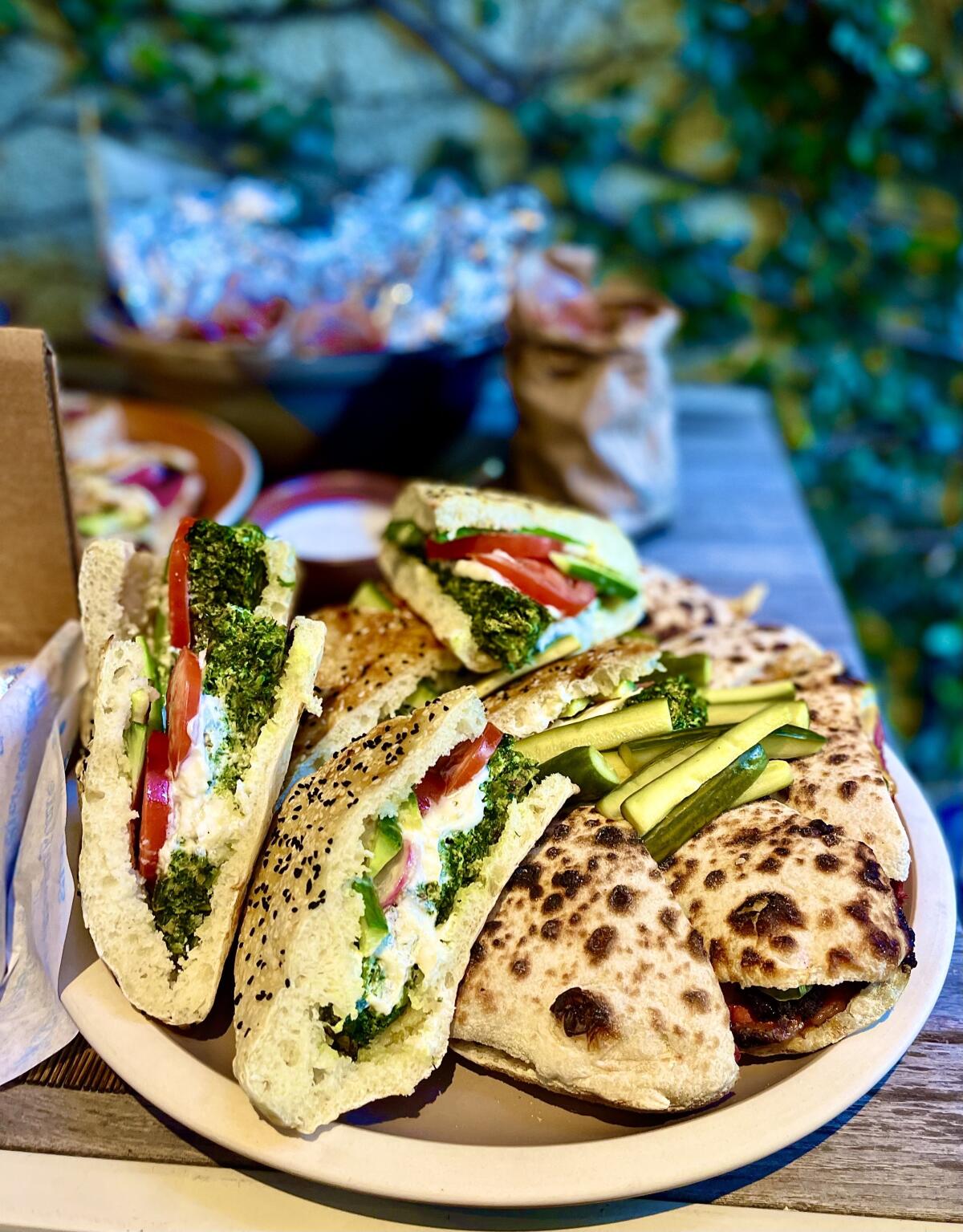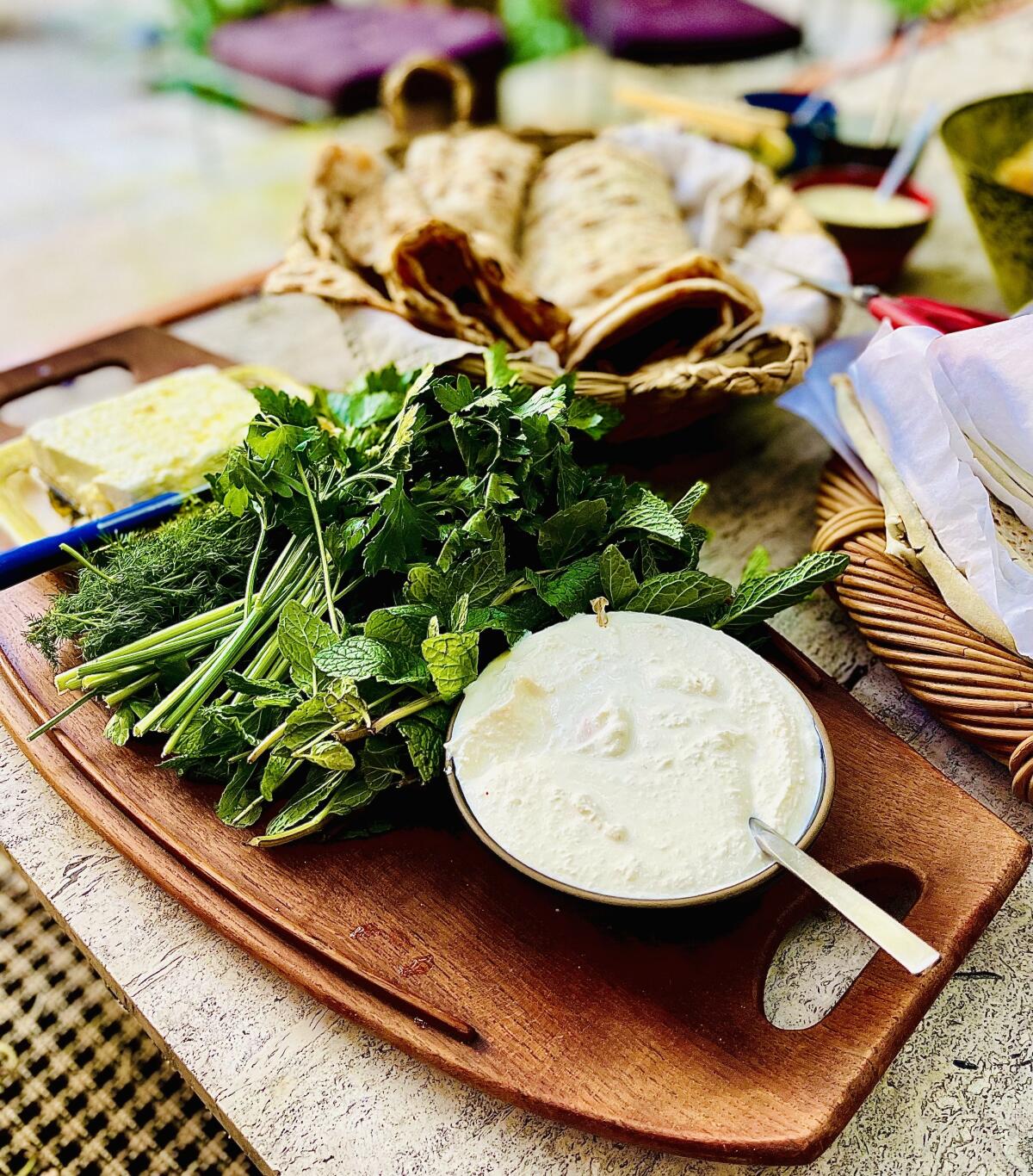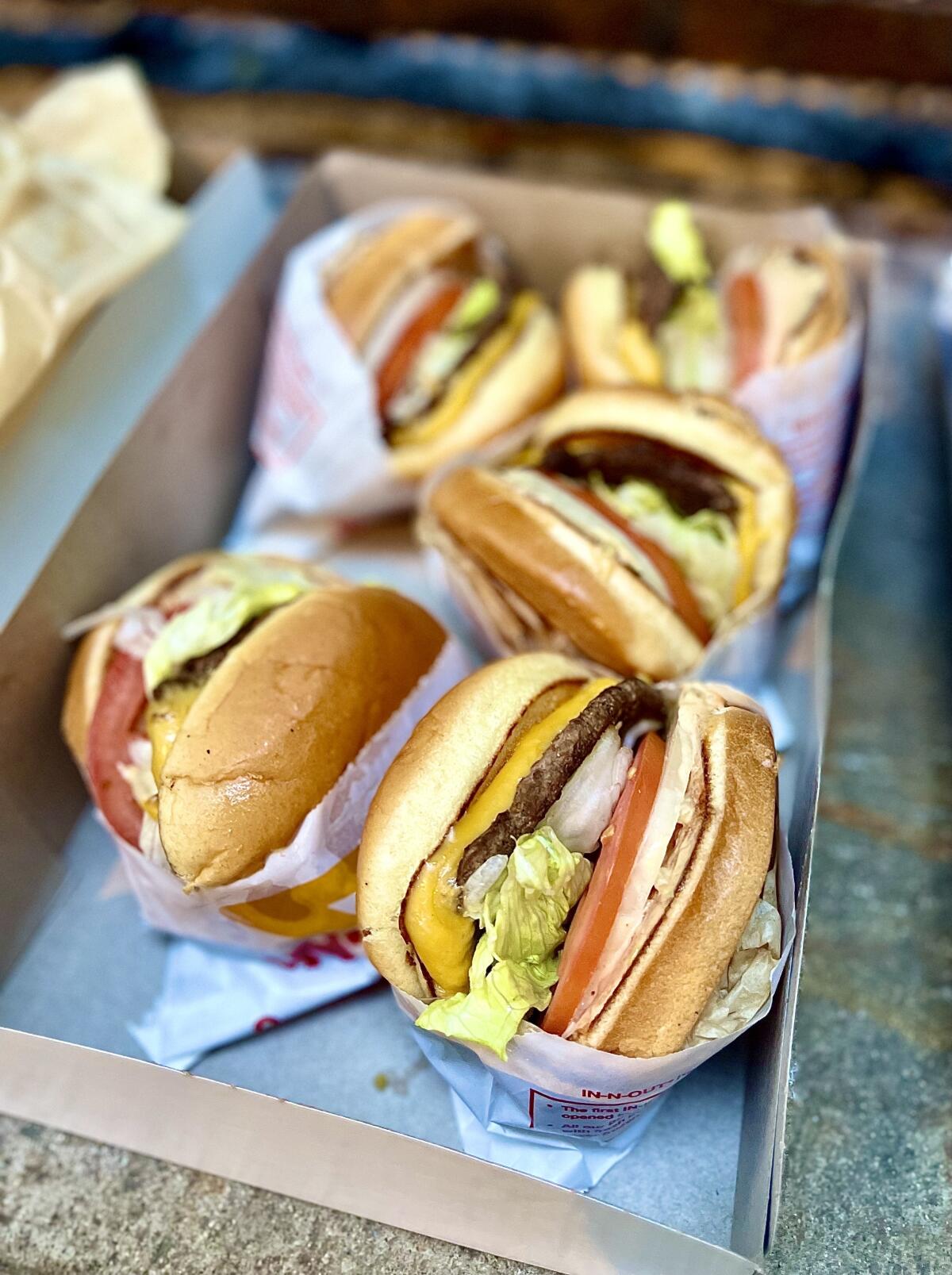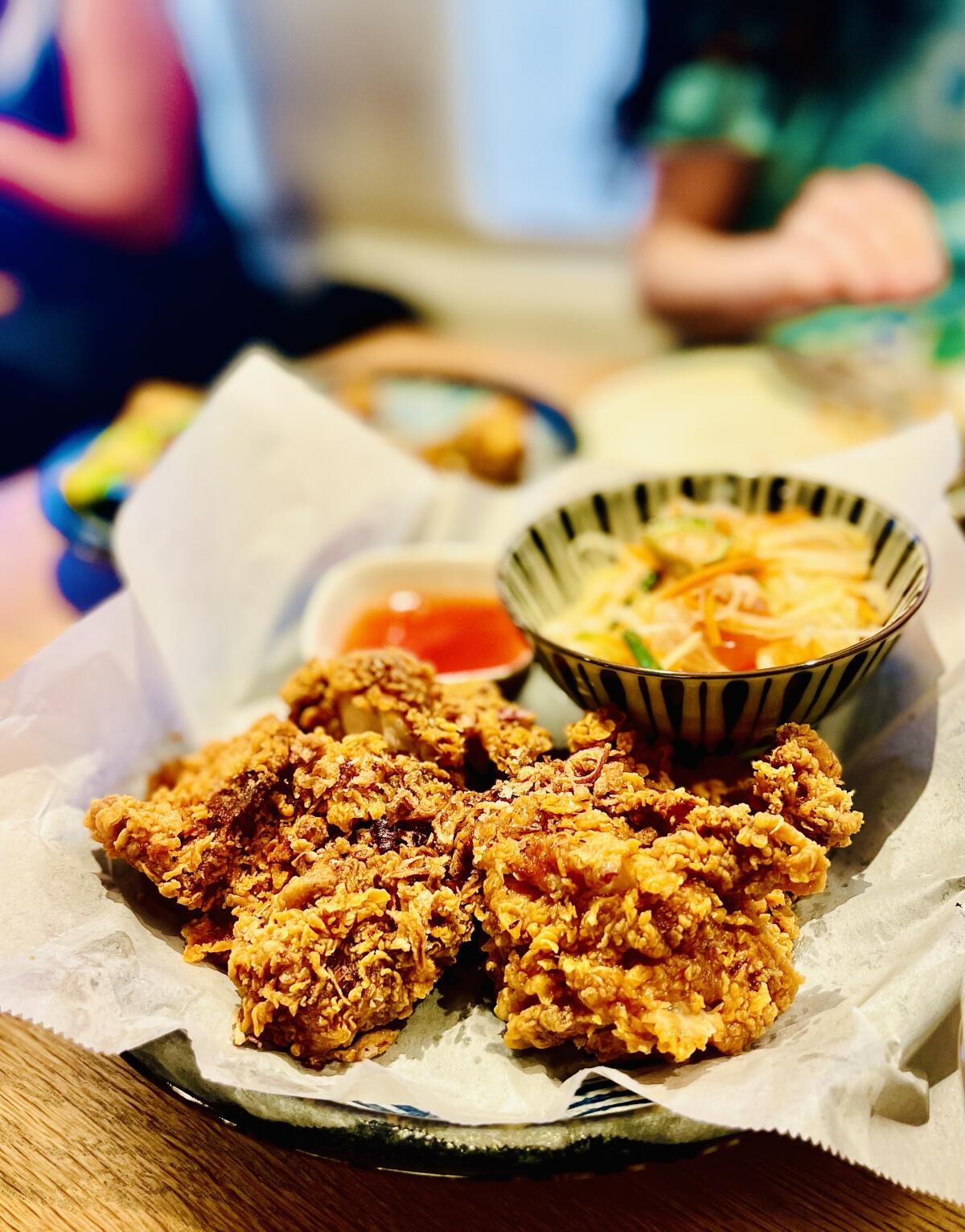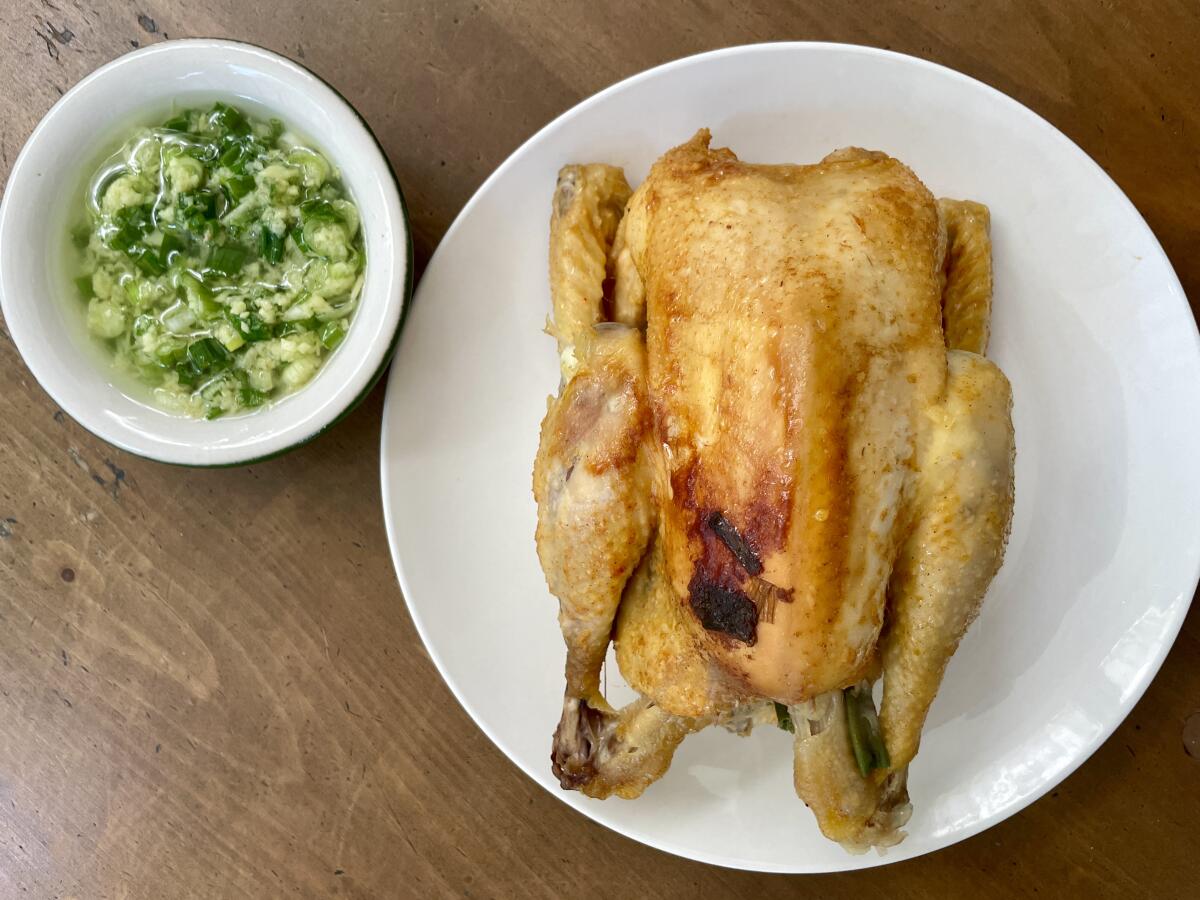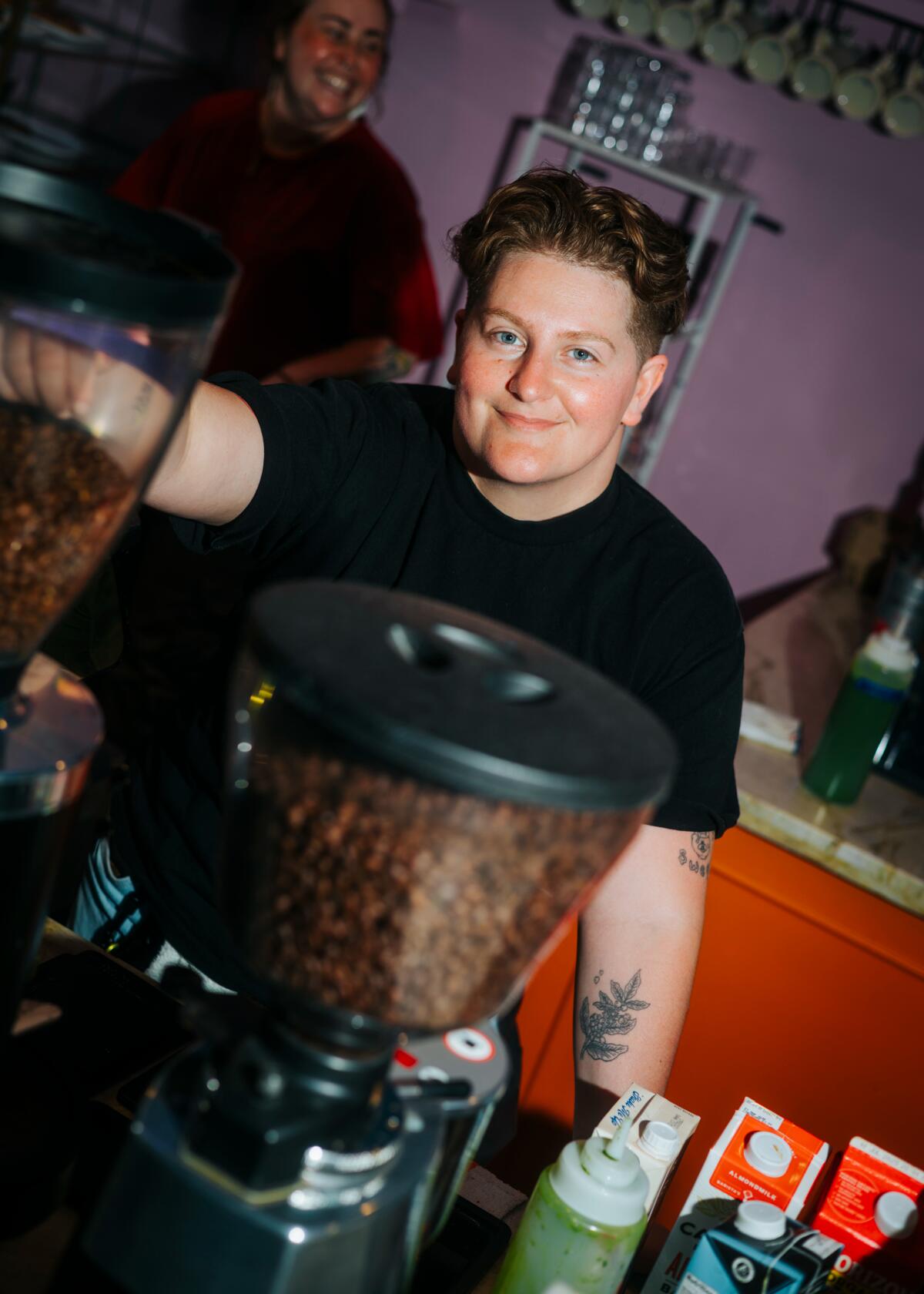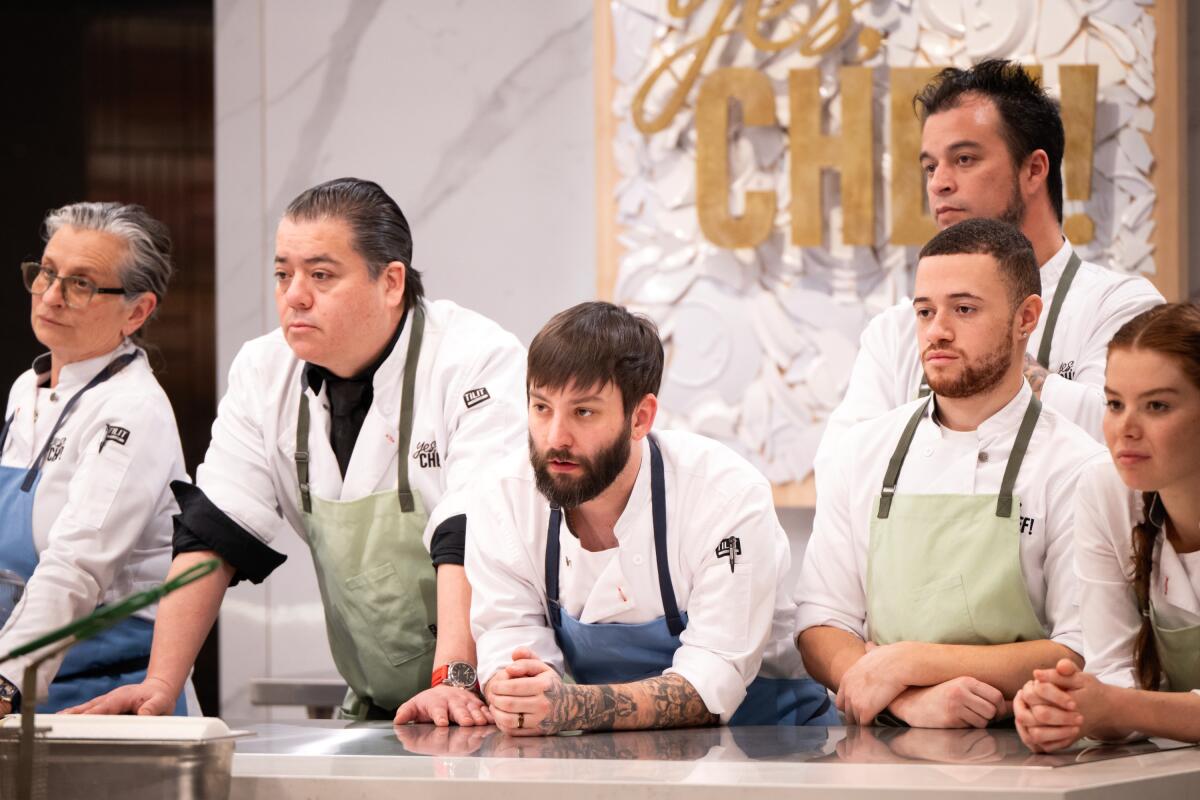Dogs, kids, pizza and fine wine: A new Altadena gathering spot
The feel of an Italian festa in Altadena, the South Bay’s “time capsule” Japanese food scene, delivery drones, a tasting menu hidden in a parking lot, more downtown L.A. closures, a Basque restaurant’s last days. Plus, recycle or reuse? And a bar that celebrates burlesque and red Solo cups. I’m Laurie Ochoa, general manager of L.A. Times Food, with this week’s Tasting Notes.
Good food, good wine, good neighbors

The happy, chaotic scene outside Good Neighbor Bar and West Altadena Wine + Spirits with families enjoying Triple Beam Pizza, one of the rotating vendors appearing during the shop and bar’s summer pop-up series.
(Laurie Ochoa / Los Angeles Times)
When I first started going to Italy for summer vacations with my late husband, Jonathan Gold, and the extended friends and family of chef Nancy Silverton, we’d get to know different areas of Umbria and Tuscany through festas or sagras, local gatherings centered around a specific regional dish or ingredient — maybe cinghiale (wild boar), porcini mushrooms, summer truffles or various pastas such as strozzapreti (which is being celebrated this week in the Umbrian town of Paciano). These are kid-friendly, come-as-you-are parties, typically on a soccer field or town square with long tables, local wine poured into plastic cups and food often served by volunteer cooks pitching in to help raise money for a good cause.
Until recently, the closest I’d come to experiencing that sagra spirit in Los Angeles was the run of summer movie nights that Leo Bulgarini used to host outside his Altadena gelateria and restaurant Bulgarini Gelato Vino Cucina. He and his crew piled plates with pasta and salad before sunset signaled the start of the movie, often an Italian comedy or melodrama, projected onto an outdoor wall or a large, jerry-rigged screen. People would bring their kids and dogs, meet up with neighbors and settle into camping chairs or benches with their wine or cups of gelato once the movie began.
Bulgarini’s restaurant, which escaped the flames of the Eaton fire in January, has yet to reopen because of smoke damage and the loss of so much of the neighborhood around his shop — not to mention the fact that he, his wife and their son lost their home in the blaze.
But two other Altadena business owners have joined forces with local restaurants to create one of the most welcoming neighborhood gatherings with the soul of an Italian sagra.
As senior food editor Danielle Dorsey wrote in the guide she and Stephanie Breijo put together on the 21 best new bars in Los Angeles, a summer pop-up series has emerged outside Good Neighbor, “the first cocktail bar to open in Altadena in 40 years,” and West Altadena Wine + Spirits, both opened last year by Randy Clement and April Langford, the couple behind Everson Royce Bar in the Arts District, Silverlake Wine and the former Pasadena wine shop Everson Royce.
On Tuesday nights, Brisa Lopez Salazar’s Casa pop-up serves tacos with a different handmade tortilla each week — maybe white heirloom corn with beet juice or masa infused with turmeric or activated charcoal. On Thursdays, Triple Beam Pizza shows up; Fridays there are oysters, poke bowls and lobster rolls from Shucks Oyster Co.; Saturdays you can get smash burgers from For the Win and, new to the line-up, Altadena’s recently reopened Miya Thai restaurant is serving on Sundays.

Triple Beam’s heirloom tomato pizza served at the summer outdoor pop-up series hosted by Good Neighbor Bar and West Altadena Wine + Spirits.
(Laurie Ochoa / Los Angeles Times)
Two weeks ago, an Instagram post from Triple Beam about its newest heirloom tomato pizza drew me to the outdoor space just outside the Altadena burn zone. I found the patio packed, sagra-style, with groups of families and friends from the neighborhood and beyond. Kids chased each other in and around a wood-chip-bedded play area fitted with reclaimed tree stumps; more freshly sawed stumps were repurposed as stools and tables around the outdoor space. Dogs sat on laps or at customers’ feet. A roving Good Neighbor barkeep took cocktail orders at the picnic tables. And on the side of the building, at a takeout-style window, a West Altadena Wine merchant was selling glasses and flights of wine.
Almost as soon as I arrived, I reconnected with a friend I hadn’t seen in years as well as a family from my daughter’s old high school. The San Gabriel mountains in the near distance turned pink and purple during sunset, framed by a U-Haul sign as we ate our pizza, which arrived with all colors and shapes of tomato. With it, we sipped Sébastien Bobinet and Émeline Calvez’s Piak blanc de noir from clear plastic cups. It was a perfect summer evening, made poignant with a stop on the way out at the wall-sized map created by Highland Park production designer Noel McCarthy marking the more than 9,000 homes and businesses destroyed or damaged in the fire, and the places where people died. The map, as writer Marah Eakin reported in April, has helped people visualize the shocking extent of the fire’s devastation, even as Good Neighbor’s summer gatherings have brought people together, a reminder of why so many want to rebuild this community.

The map Noel McCarthy made displaying the extent of damage in Altadena from the Eaton fire. It is installed outside the parking lot and patio area of the Good Neighbor Bar and West Altadena Wine + Spirits.
(Marcus Ubungen / For The Times)
Japanese food ‘made the Japanese way’
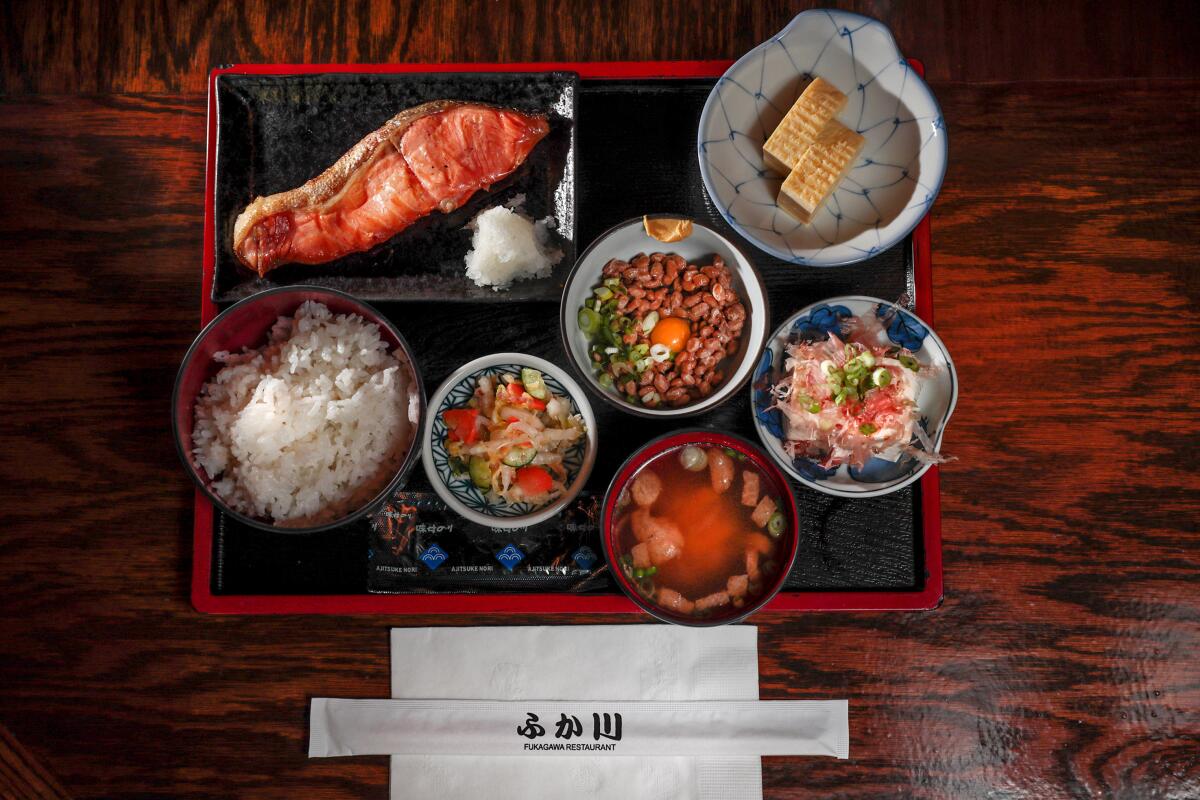
The D-Combo at Fukagawa in Gardena.
(Rob Gauthier / Los Angeles Times)
Food’s summer intern Lauren Ng is headed back to school soon, but before she left to resume her studies at New York University, the Torrance native finished a project examining the “time capsule” nature of Japanese food in the South Bay. The area is “home to the biggest suburban Japanese community in the United States,” thanks in no small part to three of Japan’s biggest automakers — Toyota, Honda and Nissan — establishing their U.S. headquarters in the region during the 1960s. The car companies are now gone, but many of the restaurants remain, with a new generation of South Bay places opened in recent years. Ng visited many of them and wrote a guide to 18 of the best Japanese restaurants and food producers in the South Bay.
A loss for Chinatown

Yue Wa Market owner Amy Tran holds up dragon fruit and cherimoya at her Chinatown market in 2019.
(Allen J. Schaben / Los Angeles Times)
In 2019, when former Times columnist Frank Shyong reported on the changes in Chinatown that contributed to the closure of Ai Hoa Market and G and G Market, he wrote that one of the few places left to buy affordable fruits and vegetables in the neighborhood was Amy Tran’s Yue Wa Market. Now, as columnist Jenn Harris wrote this week, Tran and her family will close Yue Wa next month after 18 years serving Chinatown. A spate of robberies, slow pandemic recovery, ICE raids and the forces of gentrification contributed to the family’s decision.
“I don’t feel ready to let go of the store, but there’s not much I can do to bring more people in,” Tran told Harris. “Business was booming and a lot of people used to come around, but now there is no foot traffic and a lot of people have moved away from Chinatown.”
More downtown losses: It was only a couple of weeks ago that I was at downtown L.A.’s Tokyo Fried Chicken, where, I must admit, the dining room was sparsely populated but four-wheeled robot carts were kept busy with takeout deliveries. Yet as Karla Marie Sanford reported this week, after owners Elaine and Kouji Yamanashi announced they were closing the restaurant Aug. 10, customers suddenly showed up and waited in an hours-long line for one last chance to eat the chicken known for its super-crisp skin and soy sauce-ginger marinade. It was a brief return to the restaurant’s days in its original Monterey Park location where lines for a table were constant.
The downtown location had the bad luck to open just before the pandemic and never had a chance to reach its full potential. Elaine Yamanashi told Sanford that she and her chef husband hope at some point to find a new location for Tokyo Fried Chicken. “We’re taking this time, not off,” she said, “but to reflect.”

Angel City Brewery.
(Sam Samders)
Meanwhile, Angel City Brewery, founded in 1997 by Michael Bowe then acquired in 2012 by Boston Beer — a year after the company established its downtown brewpub location notable for its distinctive neon signage that acted as a welcome to the Arts District — announced that it will close next April when the building’s lease is up.
“The brand no longer lines up with our long-term growth strategy,” said a Boston Beer spokesperson, adding that the company plans to focus on its “core national brands,” which include Samuel Adams.
And LA Cha Cha Chá in the Arts District, with its lush, tropical rooftop, is also set to close sometime this fall according to co-owner Alejandro Marín.
End of the Basque road
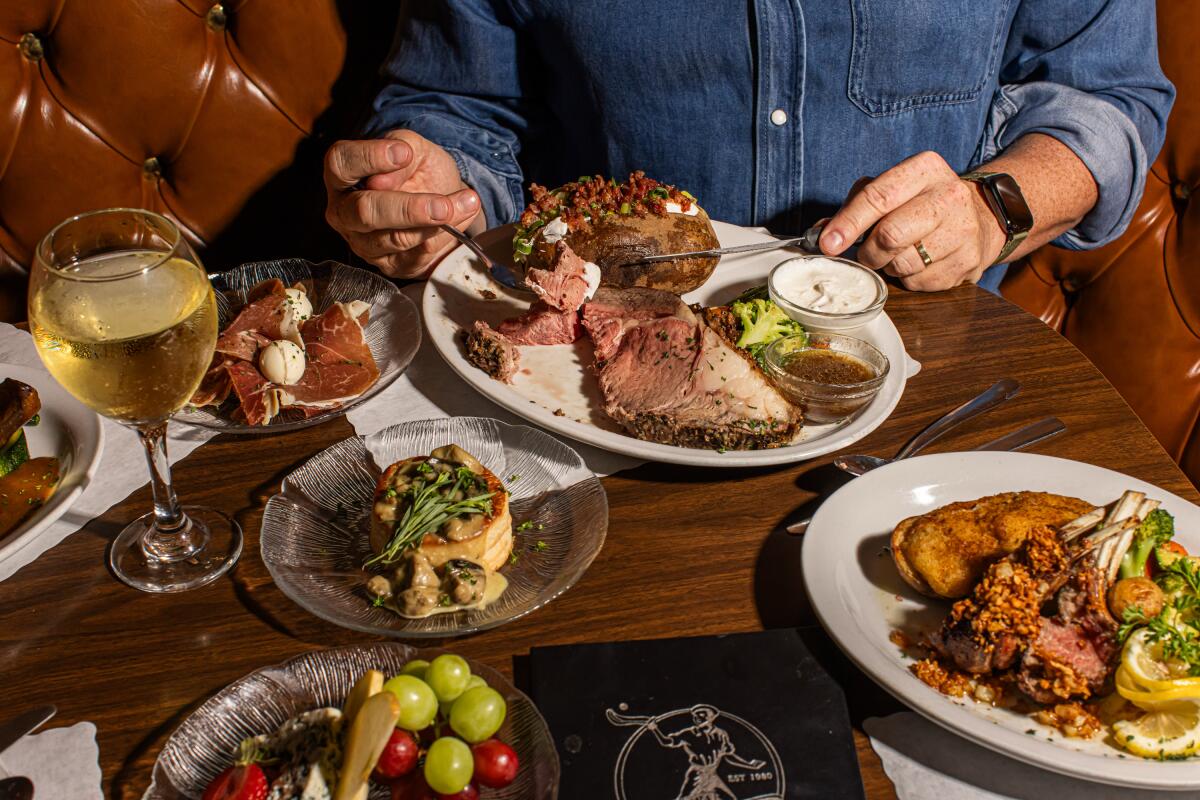
In addition to prime rib at the Glendora Continental, which is being put up for sale, French Basque dishes like slow-braised lamb in a Burgundy demi-glace, pickled tongue and escargots à la bourguignonne are on the menu, along with crab cakes and salads.
(Catherine Dzilenski / For The Times)
There wasn’t an empty seat at Glendora Continental when contributor Jean Trinh stopped into the 45-year-old restaurant on Route 66, “a reminder,” she writes, “of fading connections to the Basque diaspora in California.” Now that the owners have put the restaurant up for sale, its days are numbered so regular customers have been showing up for live music and the Continental’s “mix of Basque, French and American food,” including lamb shank, prime rib, pickled tongue and escargots à la bourguignonne. “I would say it’s Basque with a sprinkle of American,” co-owner Antoinette Sabarots told Trinh, “or vice versa.”
Yes, restaurants are still opening
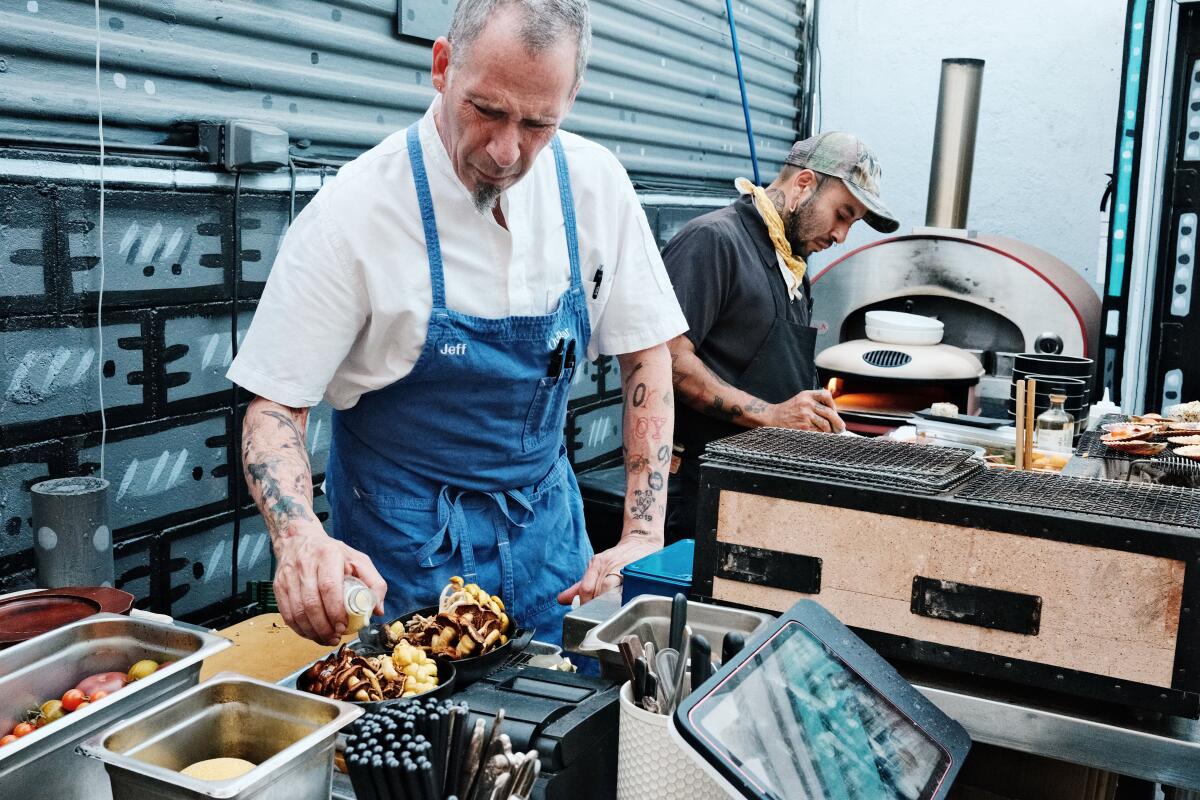
Oy Bar chef-owner Jeff Strauss, left, with sous chef Esteban Palacios at Vey, the tandem outdoor bar.
(Stephanie Breijo / Los Angeles Times)
Despite all the closure news, as Stephanie Breijo reports, good restaurants keep opening in Los Angeles, including Baby Bistro from chef Miles Thompson and his sommelier business partner, Andy Schwartz. They call it an “Angeleno bistro,” with inspiration from Japanese, Korean, Italian, Mexican, French and more cuisines. “I think the food is really defined by the cultures of Los Angeles,” Thompson told Breijo. “If you already eat at any of the regional or international restaurants in this city, you’ll find inspiring foods that go into this menu.”
And chef Jeff Strauss, of the Highland Park deli Jeff’s Table and OyBar in Studio City, has set up a weekend-only six-course tasting menu spot called Vey in the back parking lot of OyBar. As Strauss described it to Breijo, he thinks of it as “a casual, rolling omakase.”
Another hidden spot is Evan Funke’s new Bar Avoja (slang for “hell yeah”), a Hollywood cocktail lounge accessed through the dining room of the chef’s Mother Wolf restaurant. In addition to drinks, Roman street food is on the menu. Meanwhile, the chef’s namesake Beverly Hills restaurant, Funke, is temporarily closed due to a fire in the kitchen’s exhaust system on Tuesday. As Breijo reported, no one was hurt and there was minimal damage.
Also, Hong Kong’s Hi Bake chain has opened a pet-friendly branch in Beverly Hills serving “banana rolls, thousand-layer cakes, meat floss rolls and egg tarts. And San Francisco’s Boichik Bagels, which opened in Los Feliz earlier this year, is now serving at downtown L.A.’s landmark Bradbury Building.
Newsletter
You’re reading Tasting Notes
Our L.A. Times restaurant experts share insights and off-the-cuff takes on where they’re eating right now.
You may occasionally receive promotional content from the Los Angeles Times.
Burlesque and red Solo cups

Uncle Ollie’s Penthouse owner Brian Houck in the “backvan” at his downtown Los Angeles bar.
(Roger Kisby / For The Times)
Former L.A. Weekly nightlife columnist and Los Angeles magazine editor Lena Lecaro writes about Uncle Ollie’s Penthouse, a new downtown L.A. bar with “wild, color-saturated decor, potent cocktails served in red Solo cups and a soundtrack that inspires stomping the floor with pals or singing along with strangers.”
”I can’t remember the last time I felt so connected to my hometown as an L.A. native,” musician Taleen Kali told Lecaro. “I also love that you get to keep your own party cup all night — it’s a total vibe, plus it’s less wasteful and more sustainable.”
Noodles easier to make than you think

Mei Lin, chef and proprietor of 88 Club chef in Beverly Hills, right, makes mung bean noodles in the Times Test Kitchen. Left, the finished spicy mung bean noodles.
(Mark Potts / Los Angeles Times)
When Mei Lin, chef and proprietor of 88 Club in Beverly Hills and former “Top Chef” and “Tournament of Champions” winner, demonstrated her spicy mung bean noodle recipe in the Times Test Kitchen for our “Chef That!” video series, we all wanted to try making the noodles. It’s a lot easier and fun to do than most of us thought. You start with a startchy base that thickens into jelly in a bowl. After you unmold the gelatinous blob, you scrape a grater over the mound, forming the noodles. Then it’s just a matter of seasoning the noodles with chile, peanuts and herbs.
Mark the dates
The Times’ Food Bowl Night Market, this year presented by Square, is taking place Oct. 10 and 11 at City Market Social House downtown. Among the participating restaurants announced so far are Holbox, Baroo, the Brothers Sushi, OyBar, Heritage Barbecue, Crudo e Nudo, Hummingbird Ceviche House, Rossoblu, Perilla LA, Evil Cooks and Holy Basil. VIP tickets that allow early entry always go fast. Check lafoodbowl.com for tickets and info.
And at this year’s LA Chef Conference on Oct. 6, an all-day event taking place at Redbird and Vibiana in downtown L.A., I’ll be on a panel with Roy Choi, Nancy Silverton, Ludo Lefebvre and Evan Kleiman talking about the legacy of Jonathan Gold. Find information on tickets and other events at the conference here.
Also …

(Los Angeles Times photo illustration; Photo by Nick Agro/For The Times)
Newsletter
Eat your way across L.A.
Like what you’re reading? Sign up to get it in your inbox every week.
You may occasionally receive promotional content from the Los Angeles Times.

